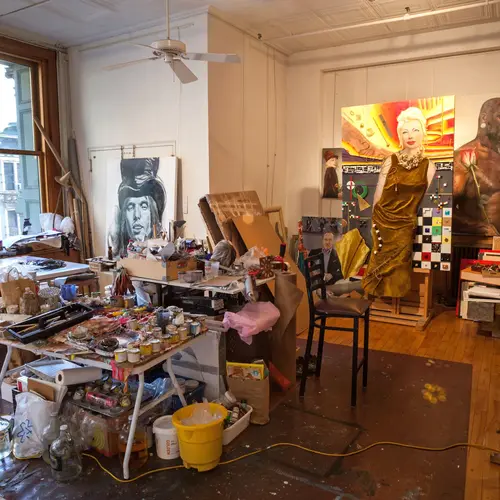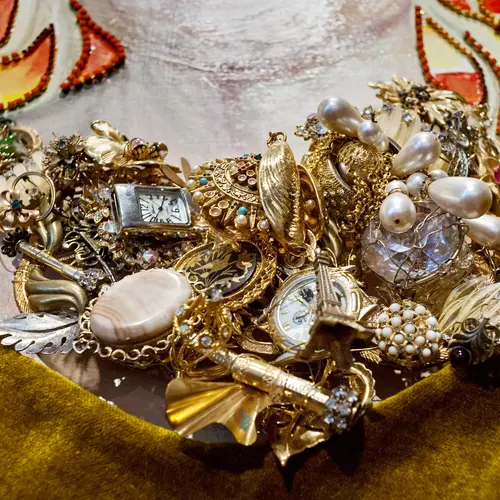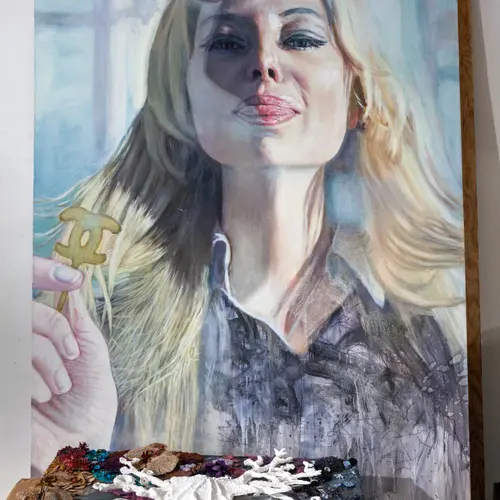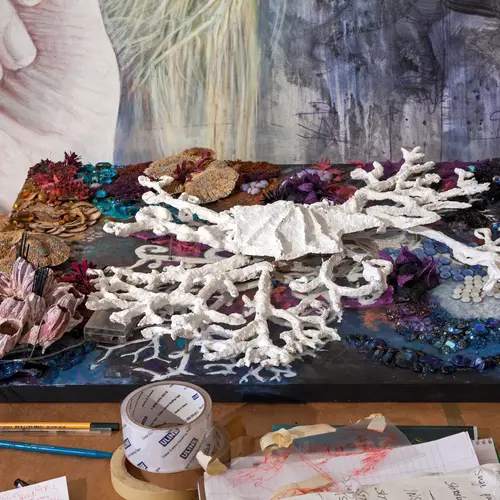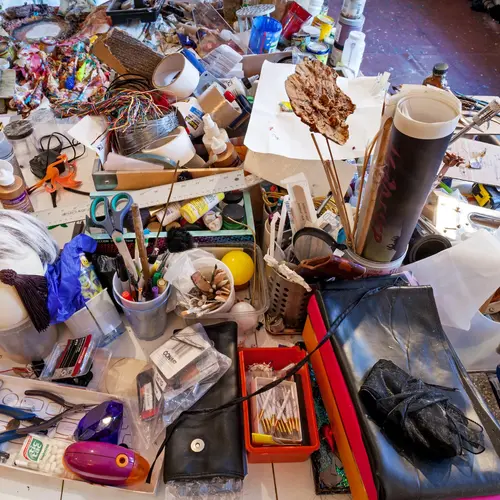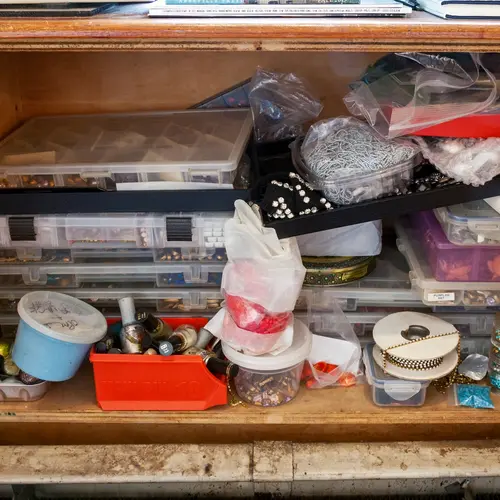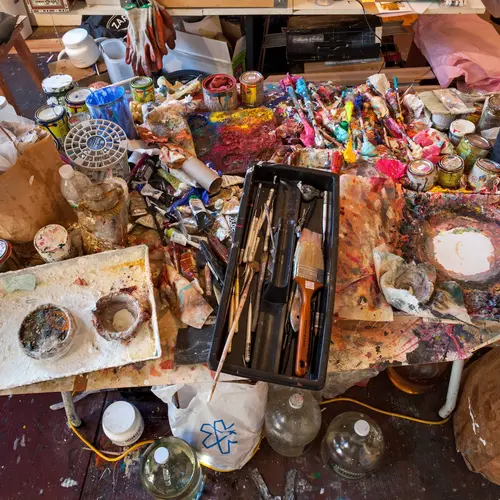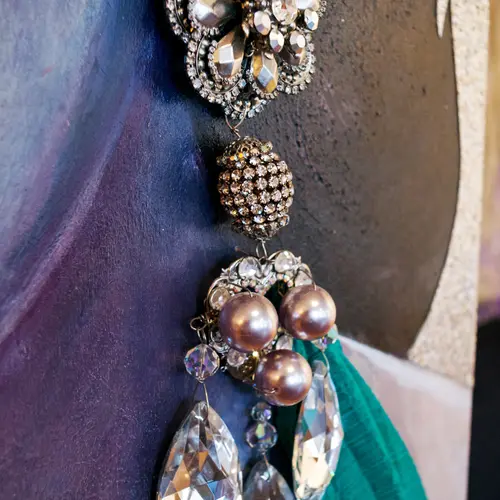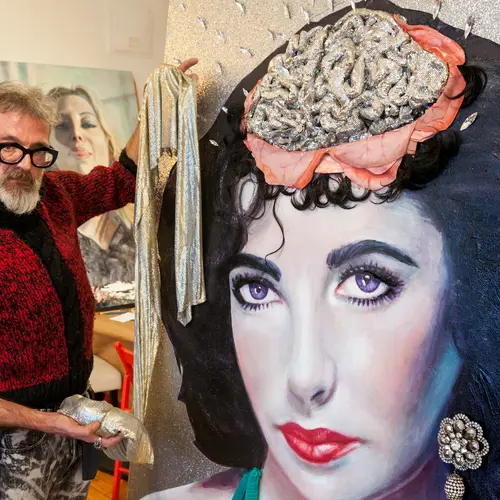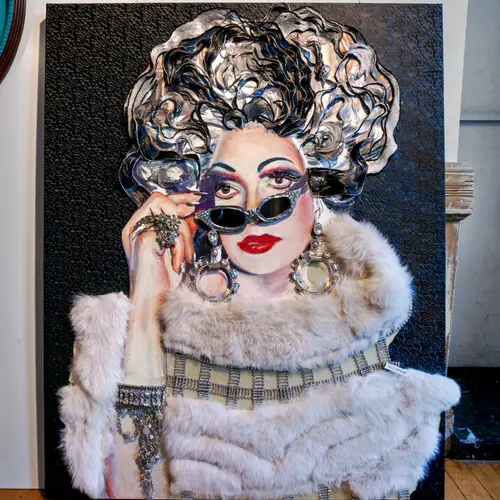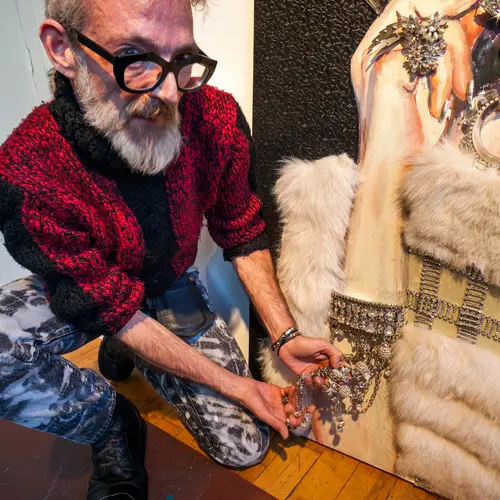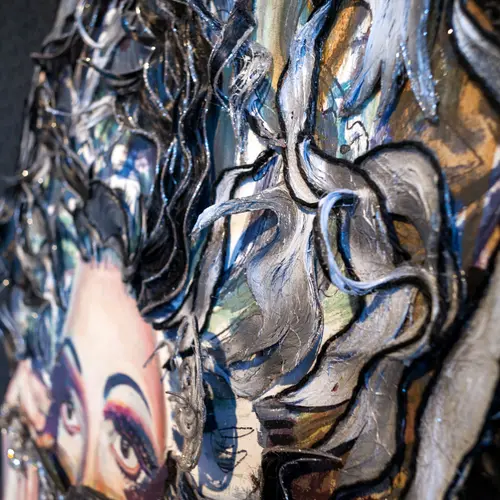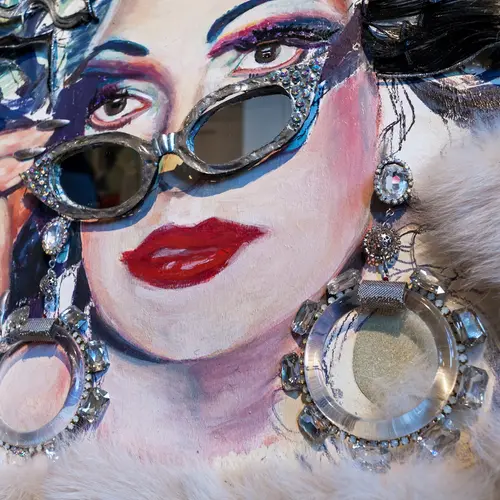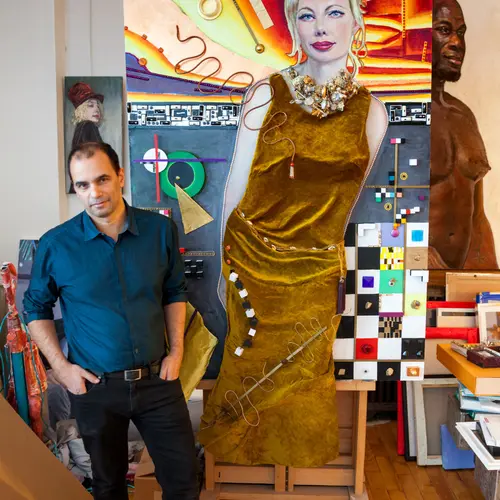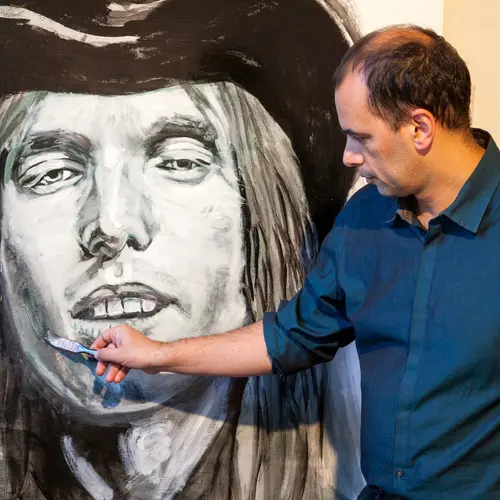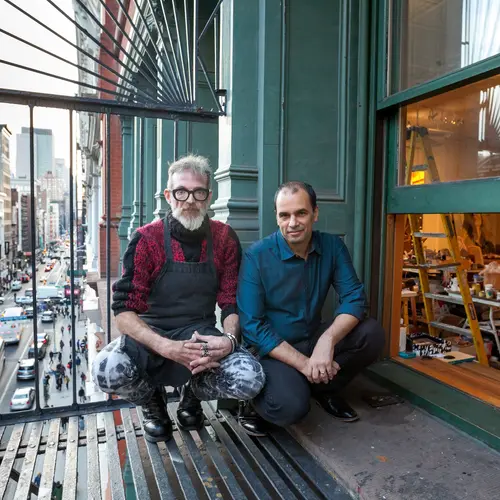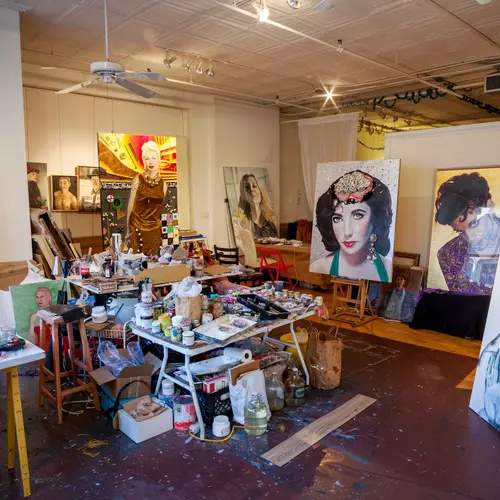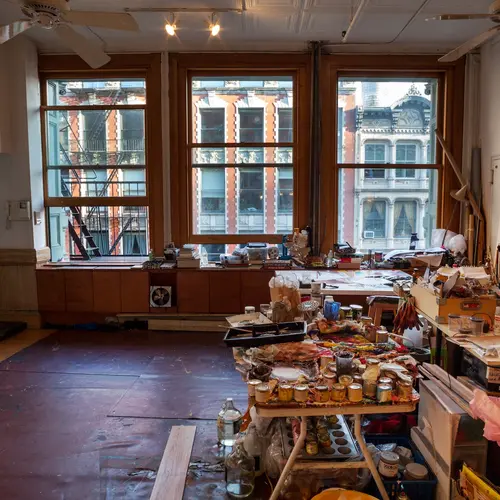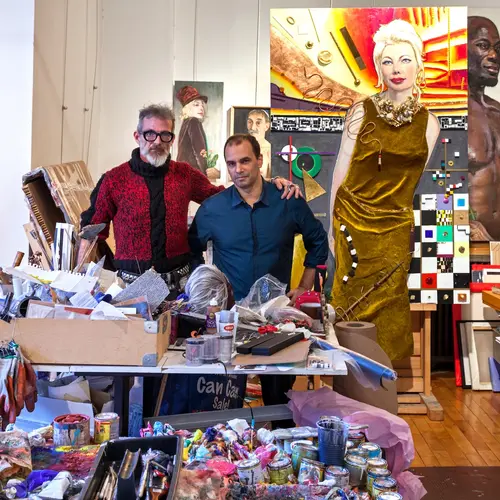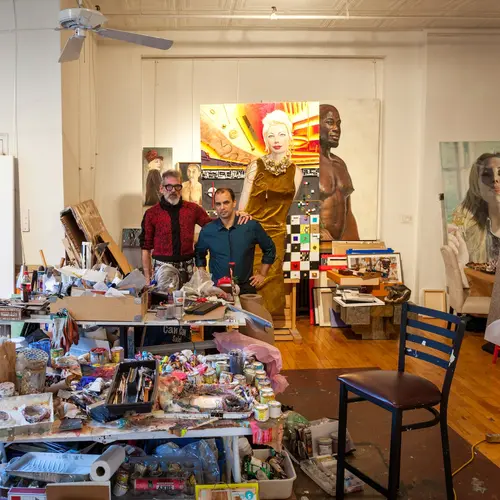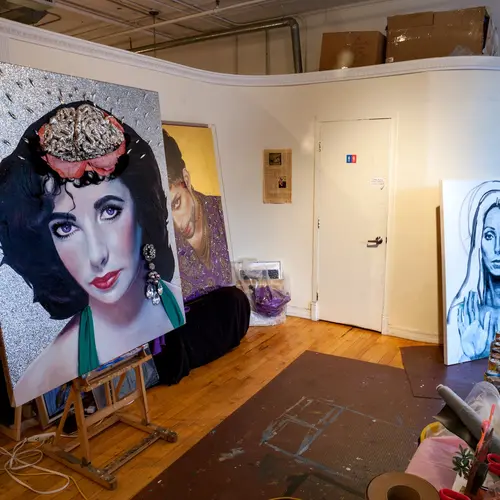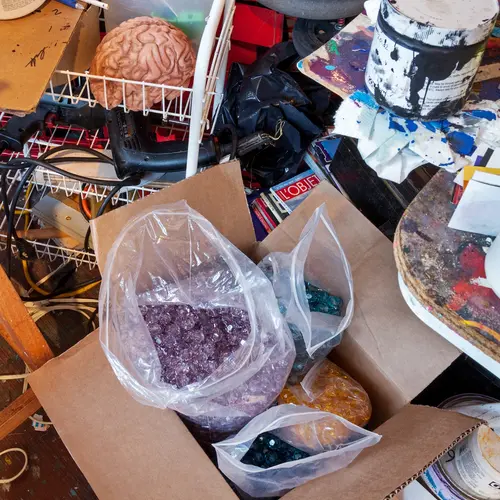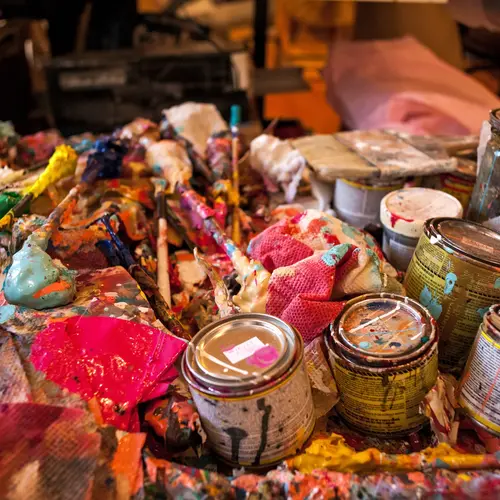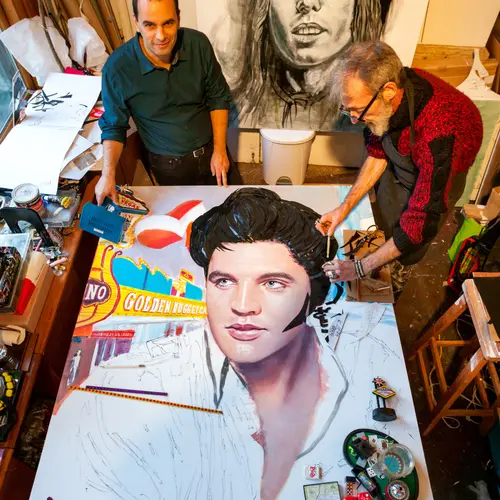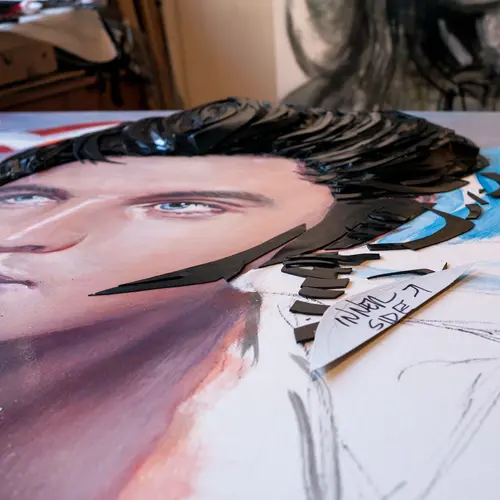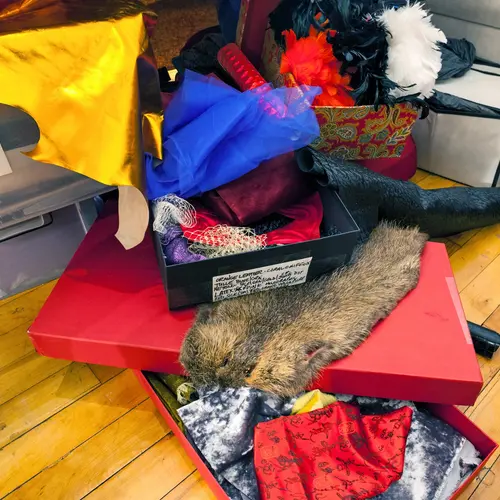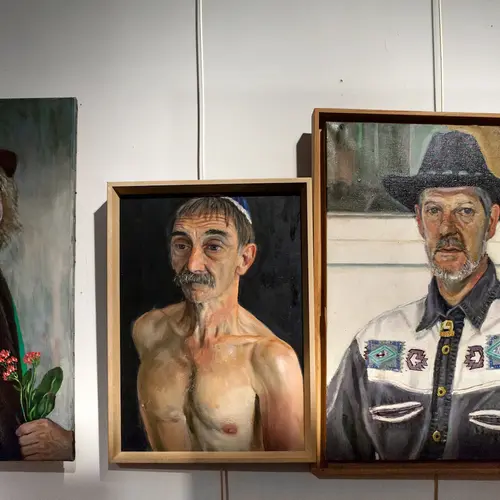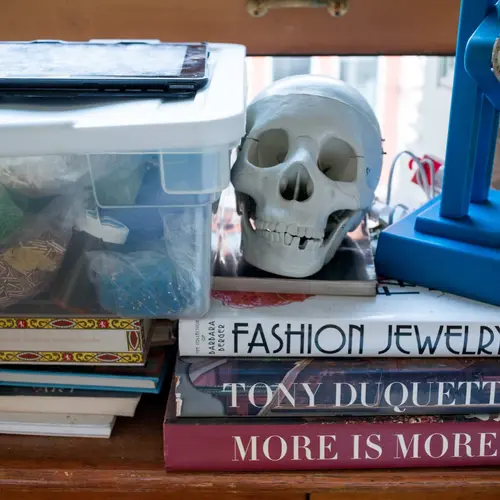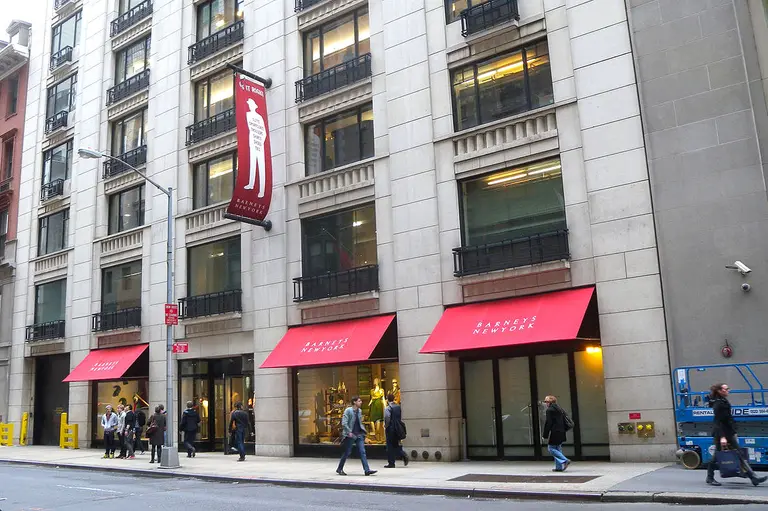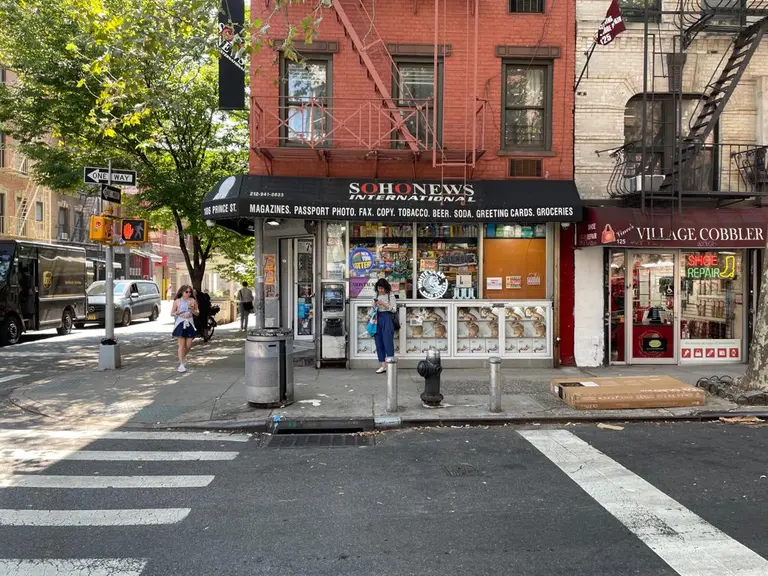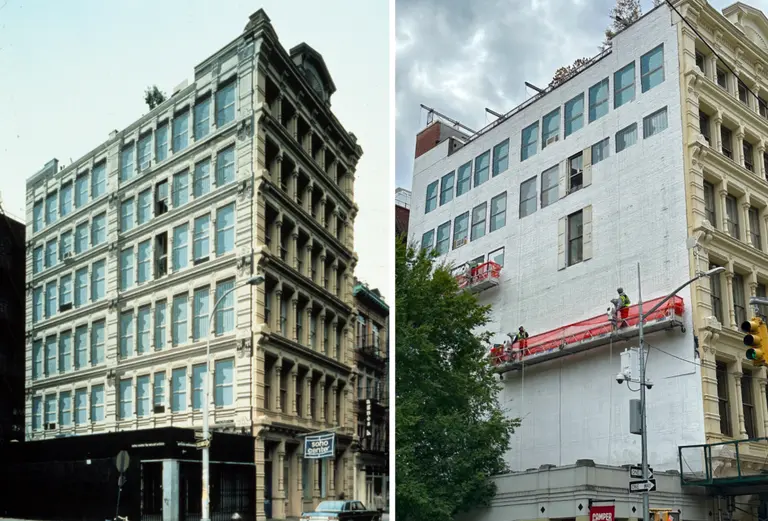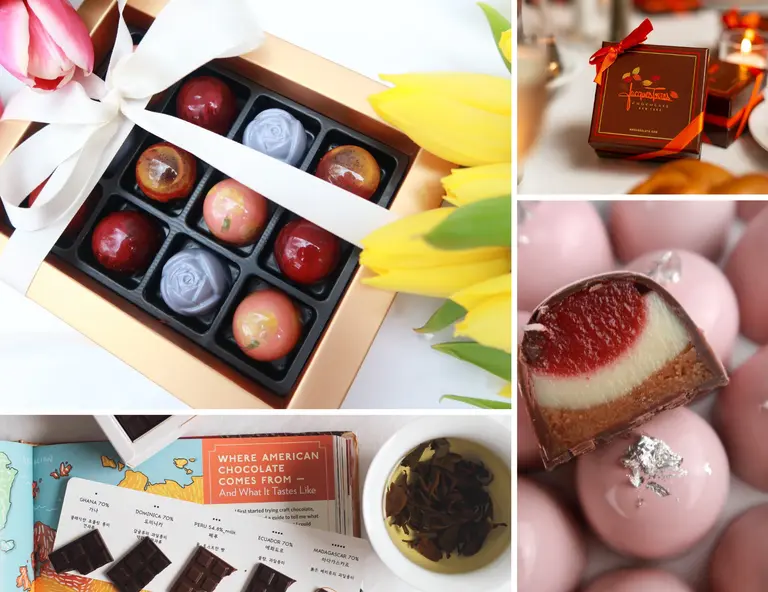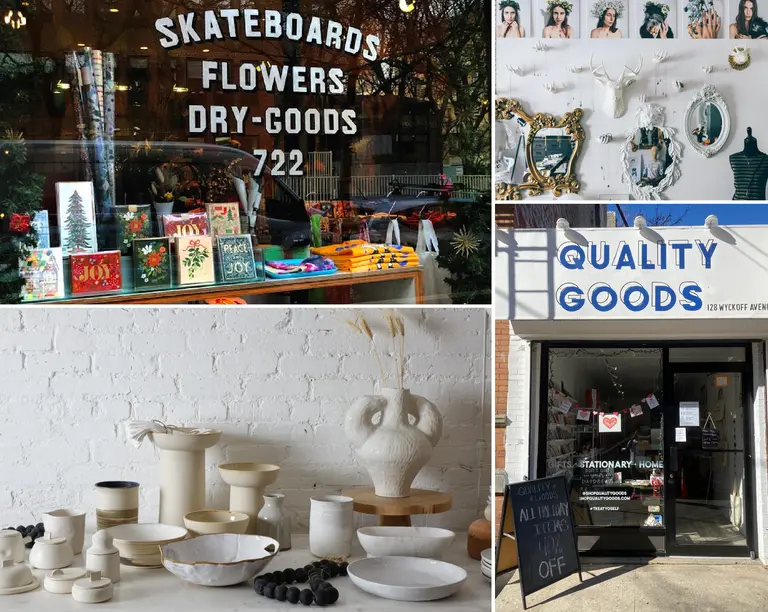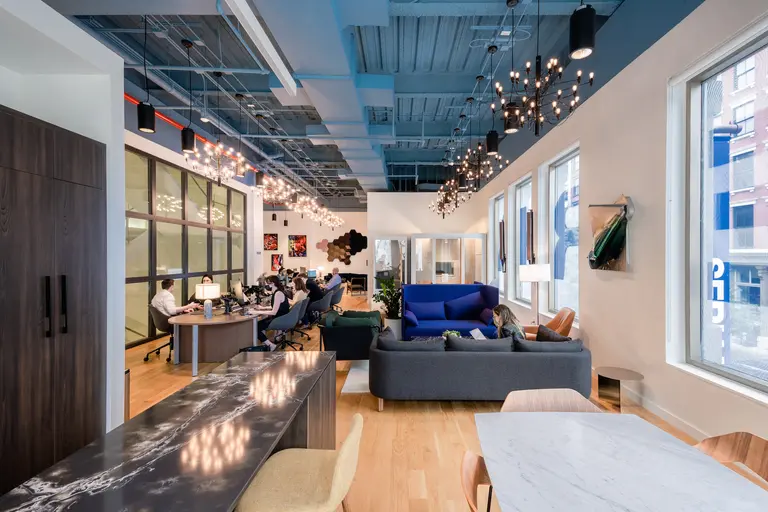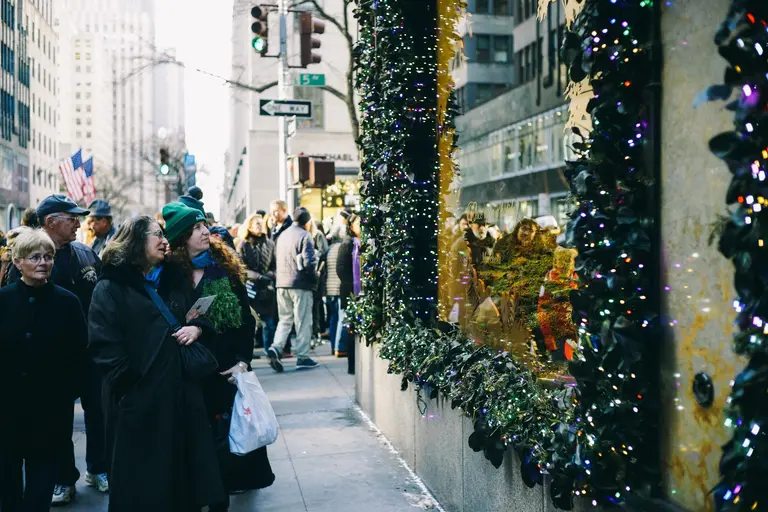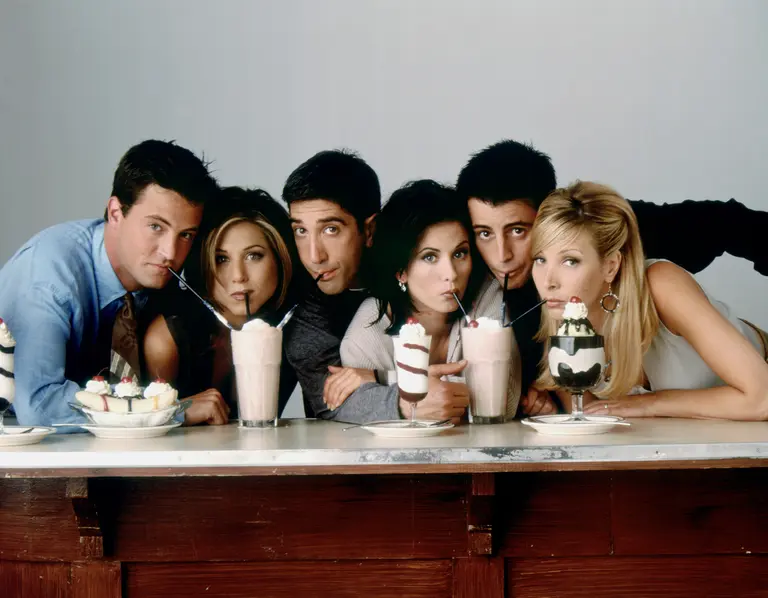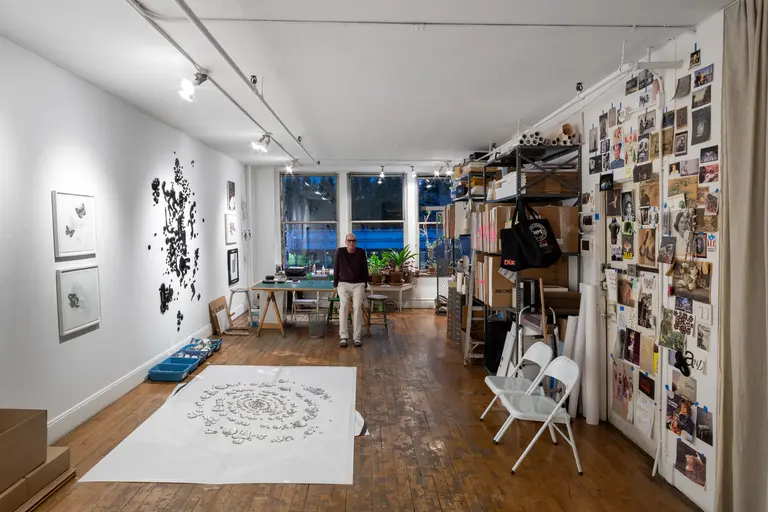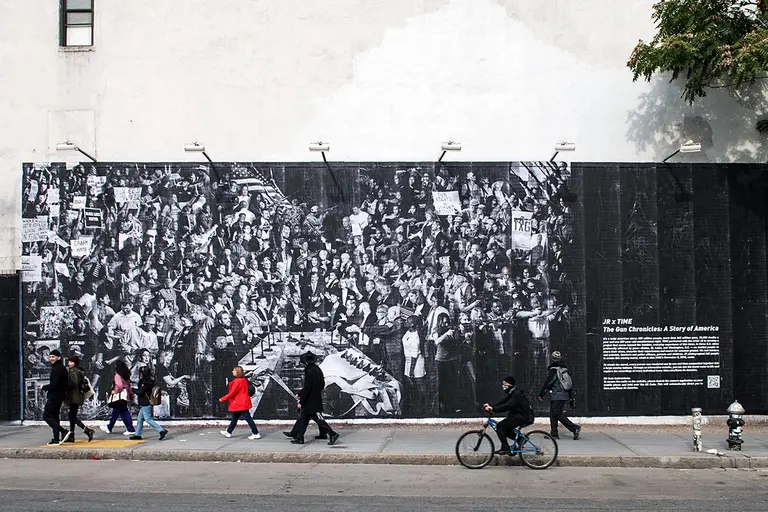Where I Work: Artistic duo Strosberg Mandel show off their Soho studio and glam portraits
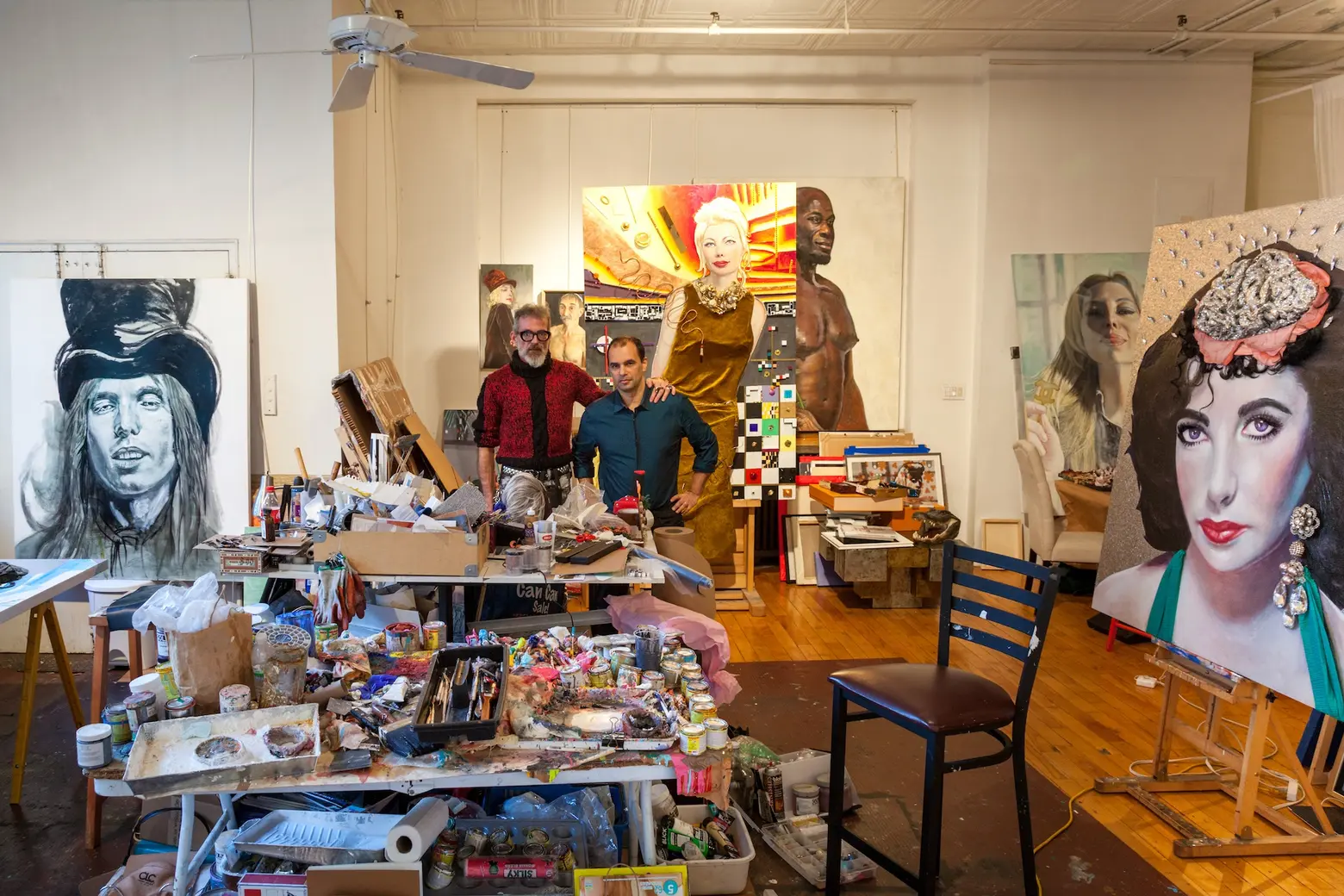
David Mandel (L) and Serge Strosberg (R) in their studio, photo by James and Karla Murray
6sqft’s series “Where I Work” takes us into the studios, offices, and off-beat workspaces of New Yorkers across the city. In this installment, we’re touring artistic duo Strosberg Mandel‘s Soho studio.Want to see your business featured here? Get in touch!
Last year, Belgian-American figurative painter Serge Strosberg had an exhibit about feminism in the East Village. The show’s curator introduced him to David Mandel, a theatrical stylist, jewelry designer, and former drag queen. Though the two came from very different artistic backgrounds, they immediately hit it off on both a personal and professional level. Fast forward to today, and they’ve formed the NYC-based artistic duo Strosberg Mandel, creating large-scale assemblage portraits–mostly of rock n’ roll icons such as Prince, David Bowie, Elvis, and Cher–using found materials and glamorous add-ons like Swarovski diamonds and luxury fabrics.
In anticipation of their upcoming debut solo exhibition “Troubadours of Eternity” at Lichtundfire from January 24th to February 4th, in which they’ll unveil the full portrait series as “a celebration of authentic musicianship and timeless spirits,” Serge and David invited us into their Soho studio to get an advanced preview of the pieces and learn about their unique work and partnership.
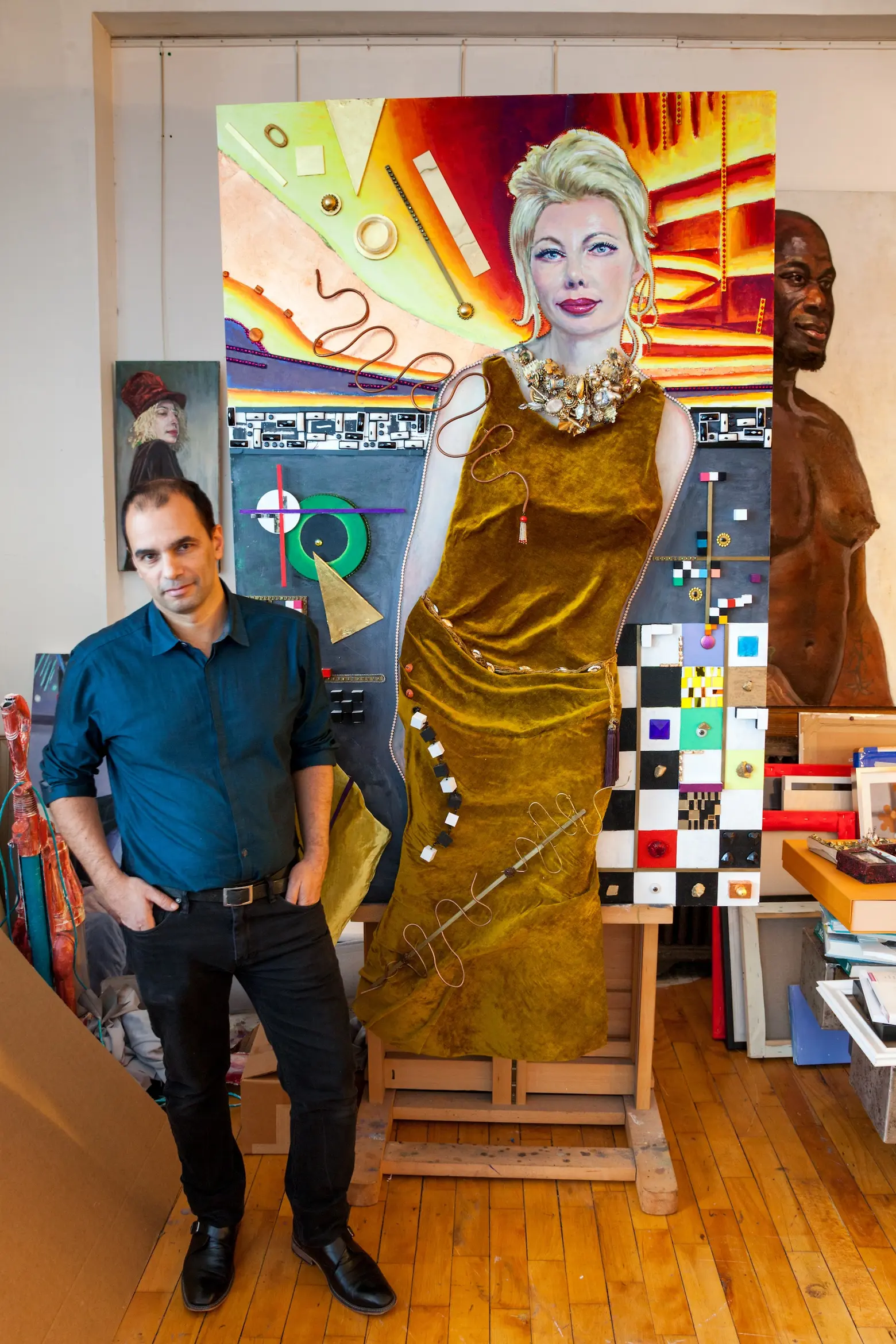
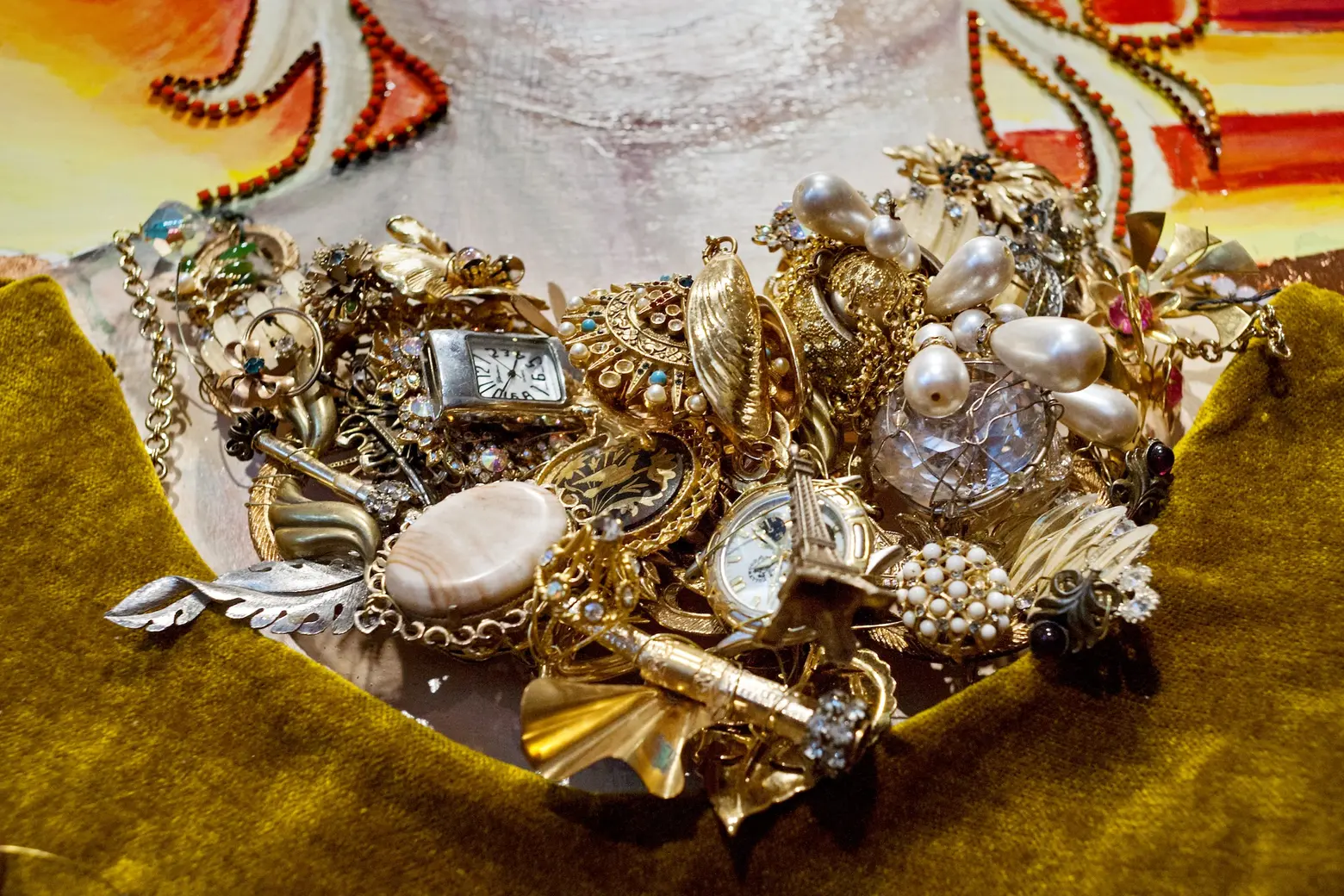
Can you each tell us a bit about your backgrounds?
Serge: Now an American citizen, I was born in Antwerp, Belgium, lived for about 25 years in Paris, and spent the rest of my life in various parts of the United States. I was trained as an illustrator at Academie Julian (Paris) and learned the difficult and beautiful technique of oil and egg tempera from a German expressionist painter, Joerg Hermle. After writing and illustrating several children books in France, one of which became an international bestseller (“In the Dragon Kingdom”), I started a career in portrait commissions and figurative painting, which first took me to Hampstead in London, Palm Beach, and eventually New York City.
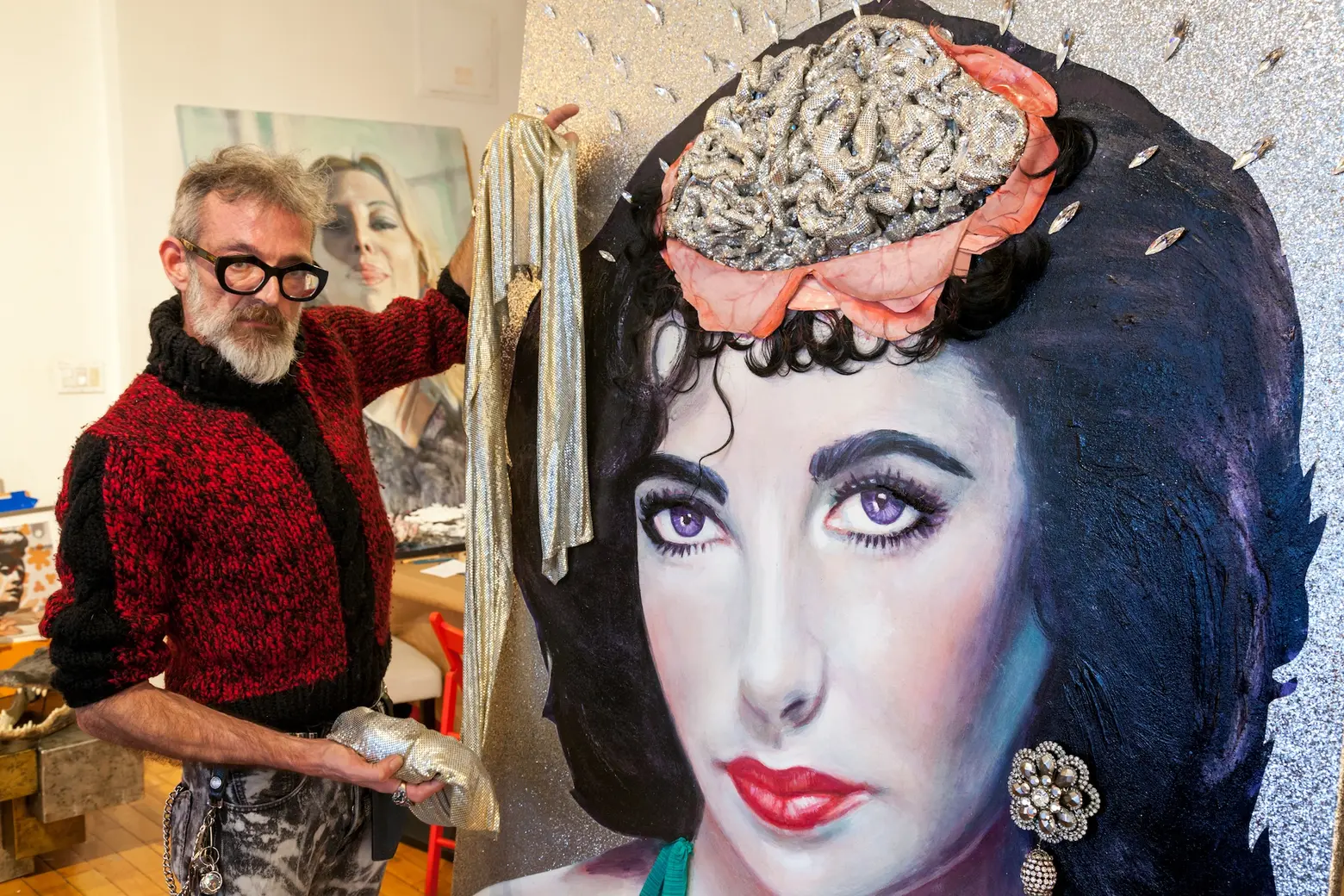
David: I was born in 1963 in a loosely observant Jewish northern New Jersey family with a pinch of Italian. My father was an artist and my mother dreamed of being an English teacher; I had a very creative atmosphere ignited by trips to the Washington Square Park art shows in the city. As an adolescent, I took night classes, learning techniques in many disciplines–stained glass windows, watercolor, sculpture. But I thank Lillian, my maternal grandmother, for allowing me to play in her sacred drawers where she kept all of her costume jewelry. Drawn in by the rhinestone evening jewelry counter at the local discount department store, I knew that I wanted to create jewelry fit for movie stars. During this period I opened a small jewelry business with the help of my parents and sold to teachers and other mothers in the PTA.
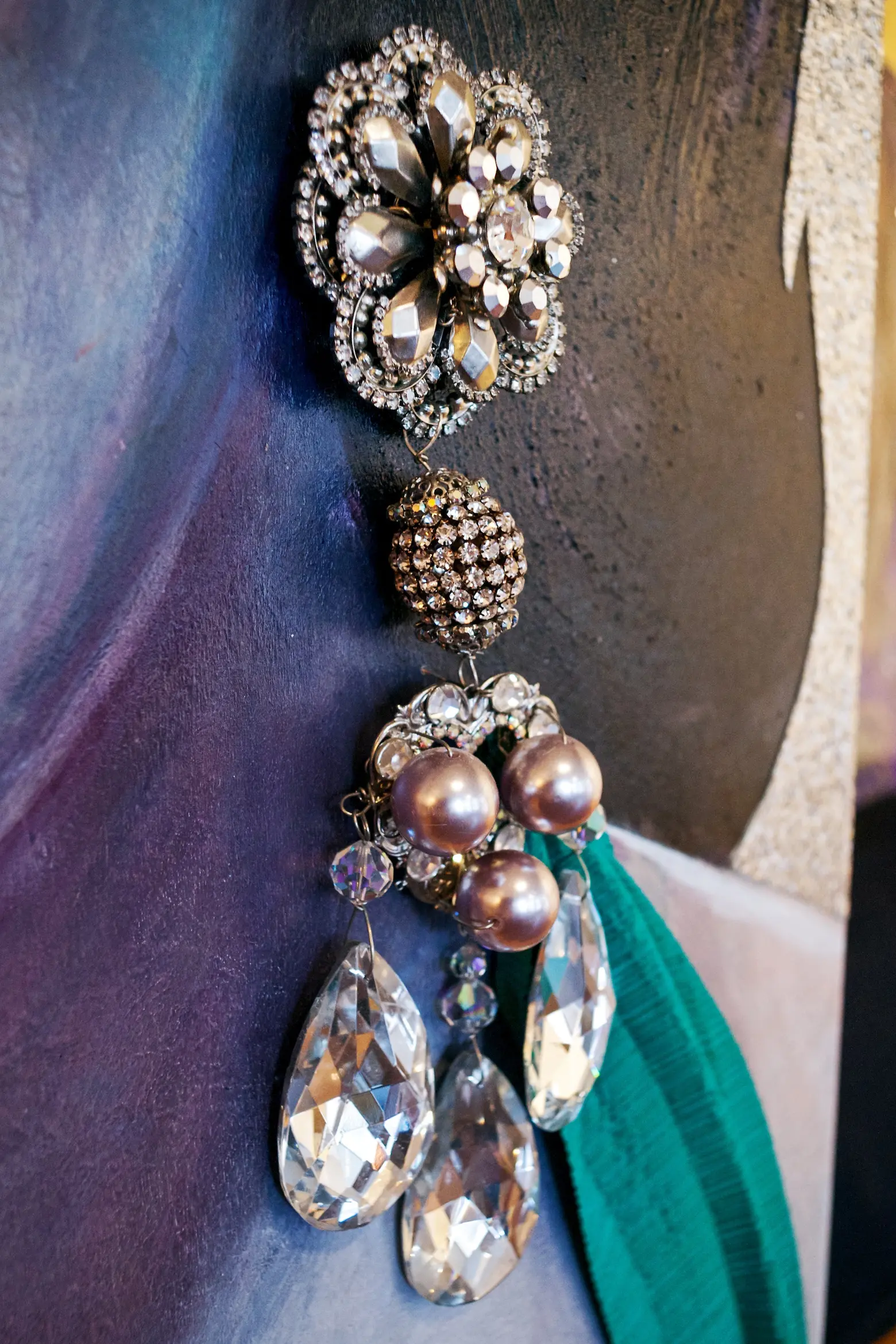
Fast forward to high school with one thing on my mind–“How do I get myself to be a part of the fabulous world of NYC?” As a kid, what started as an innocent gender playing game became a serious part of my life. I would be a transformist. Understanding the dangers of breaking society’s “rules,” I had to keep this hidden, except when it came to Halloween. Becoming part of the biggest drag fundraising organization in North America, the Imperial Court of New York, was rewarding at many levels. I began an apprenticeship with one of costume jewelry’s finest designers, Larry Vrba, while studying full time at the Art Students League under the mentoring of collagist Leo Manso and mixed media artist Bruce Dorfman. For six years at the League, I was part of group shows held at Lincoln Center and the yearly concourse show at the ASL’s historic 57th Street building.
Some highlights of my jewelry career are creating wings for the Victoria’s Secret fashion shows and couture jewelry for fashion designer Naeem Khan. Having survived the early 80’s nightlife, I added collage, installation, sculpture, and drag performances to my list of mediums. Since that time, I never stopped experiencing, producing, learning.
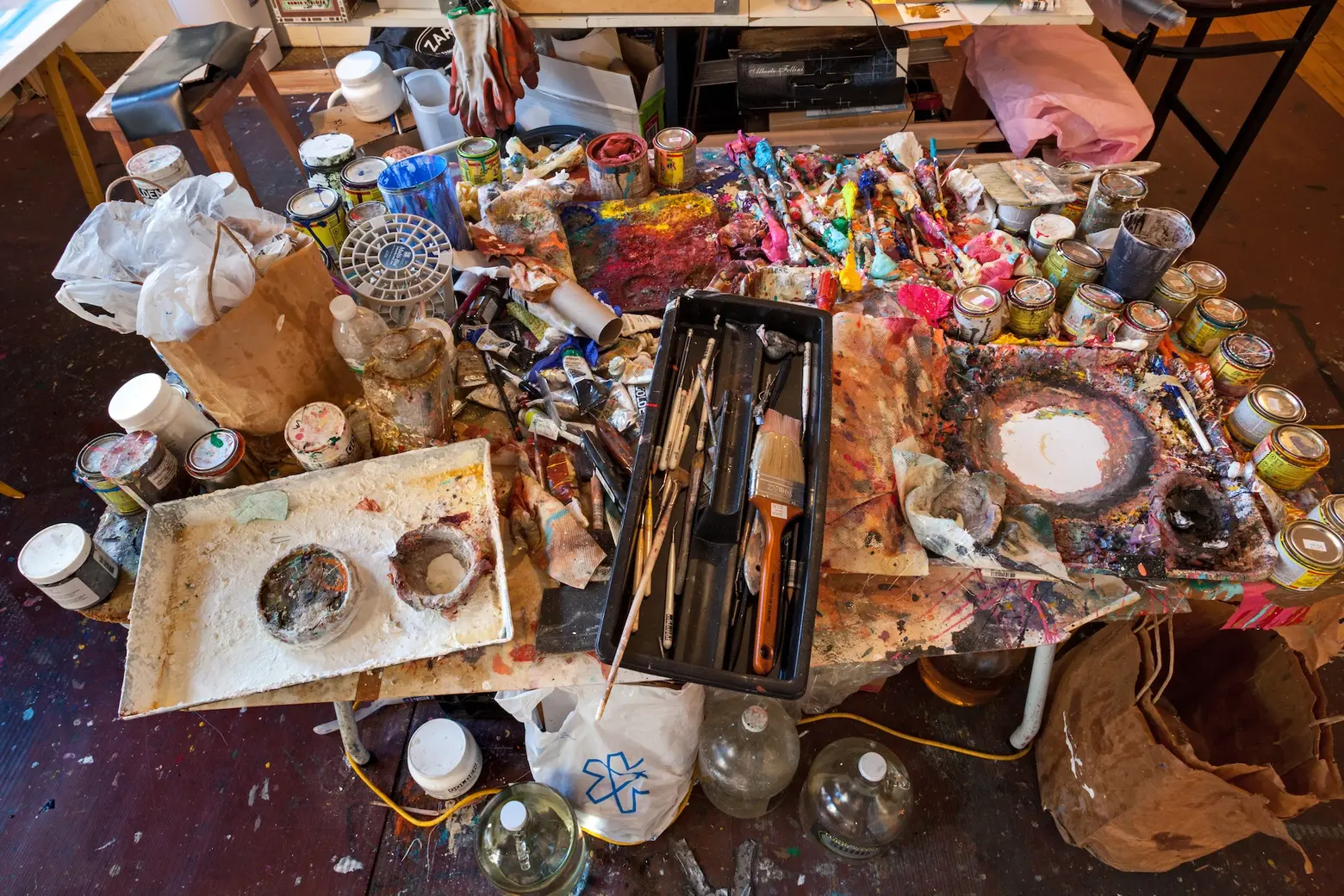
How did you meet and what made you decide to start working together?
Serge: In April 2016, I was having the solo exhibition “GirlsGirlsGirls” at Studio 26 Gallery on the complex relationship between feminism and adult movies. I transformed the space into a fake adult movie store filled with feminist posters and imagery with neon signs to lure outsiders from the street. David and I met through the curator. He gave me precious advice to build the store and made the two neon signs. Later, I ordered jewelry from him for my wife Olga and we became friends.
After seeing some portraits by renaissance painter Hans Holbein, which have ornaments and jewelry and are very contemporary, I thought of David and his ability to add dimension in a fantastic and original way. I was always told that my portraiture was alive and dimensional, but I thought with David’s skills, it could become dimensional in a way that has never been done before. I contacted him about collaborating on a portrait of Prince, who had just passed away, and that’s how Strosberg Mandel was born. Since then, David has also encouraged me to diversify and work on subjects that are not exclusively portraits, such as meat and underwater landscapes.
You mentioned several times that you’re not only colleagues but friends. Why do you think this is important?
Serge: New York is a jungle, especially the art and jewelry worlds. It’s very hard to make friends here unless you went to school or college with someone.With David, I found loyalty and support as a friend. We often joke about our common ancestry from eastern Europe. Perhaps our great-great-great grandparents were from the same shtetl. In the two years we have been working together, we both had important personal events, some good, some very tragic, but we always support each other and overcome obstacles.
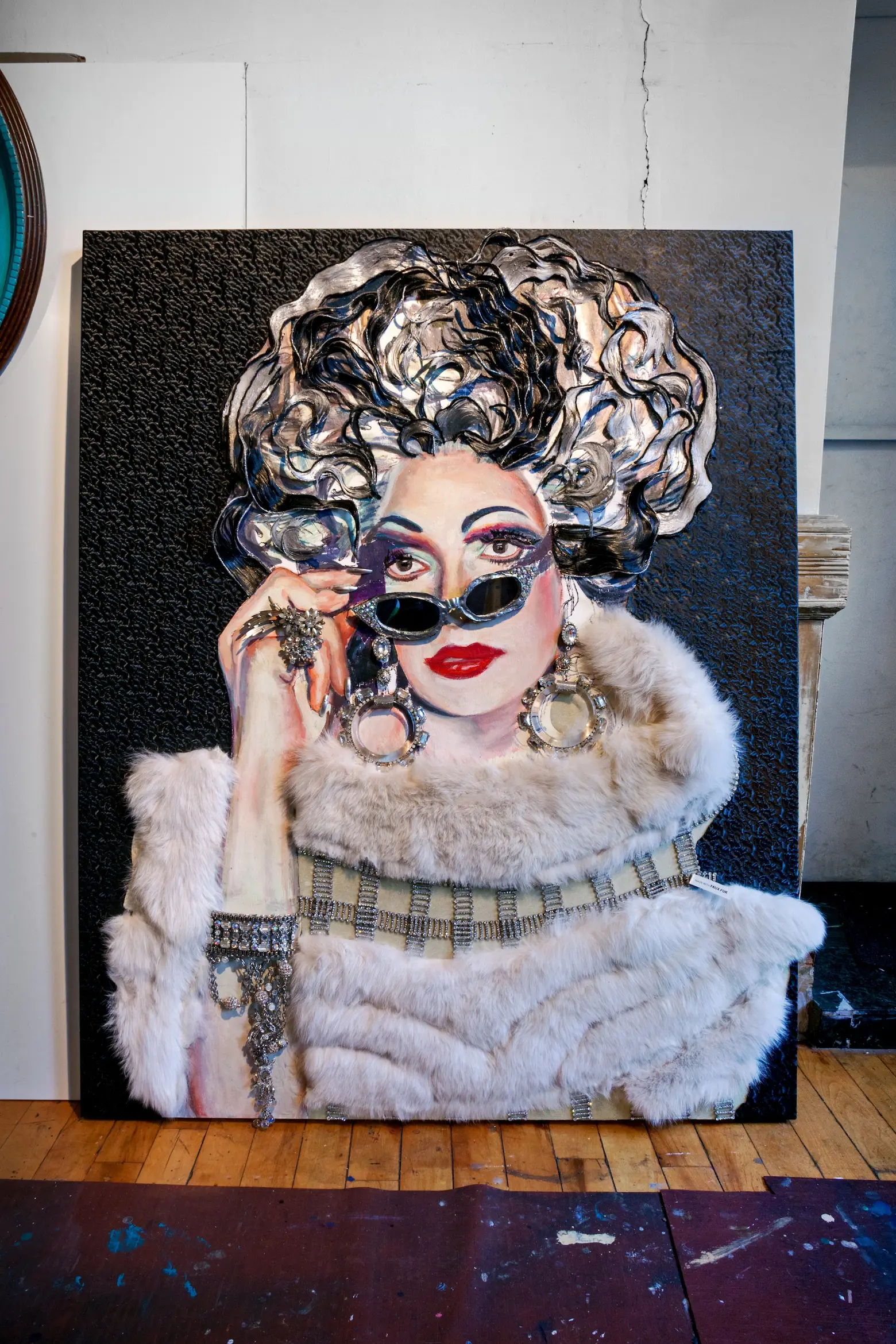
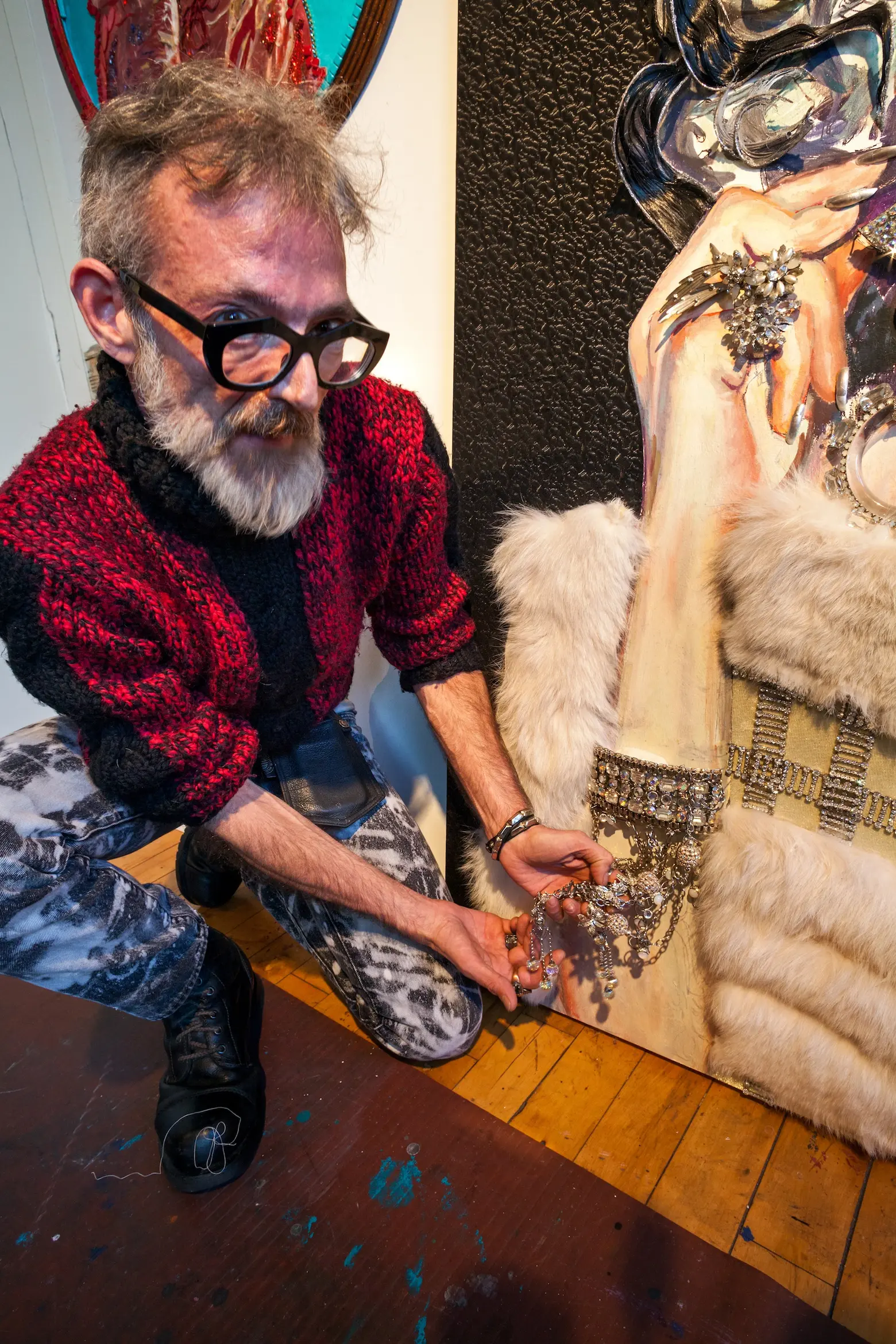
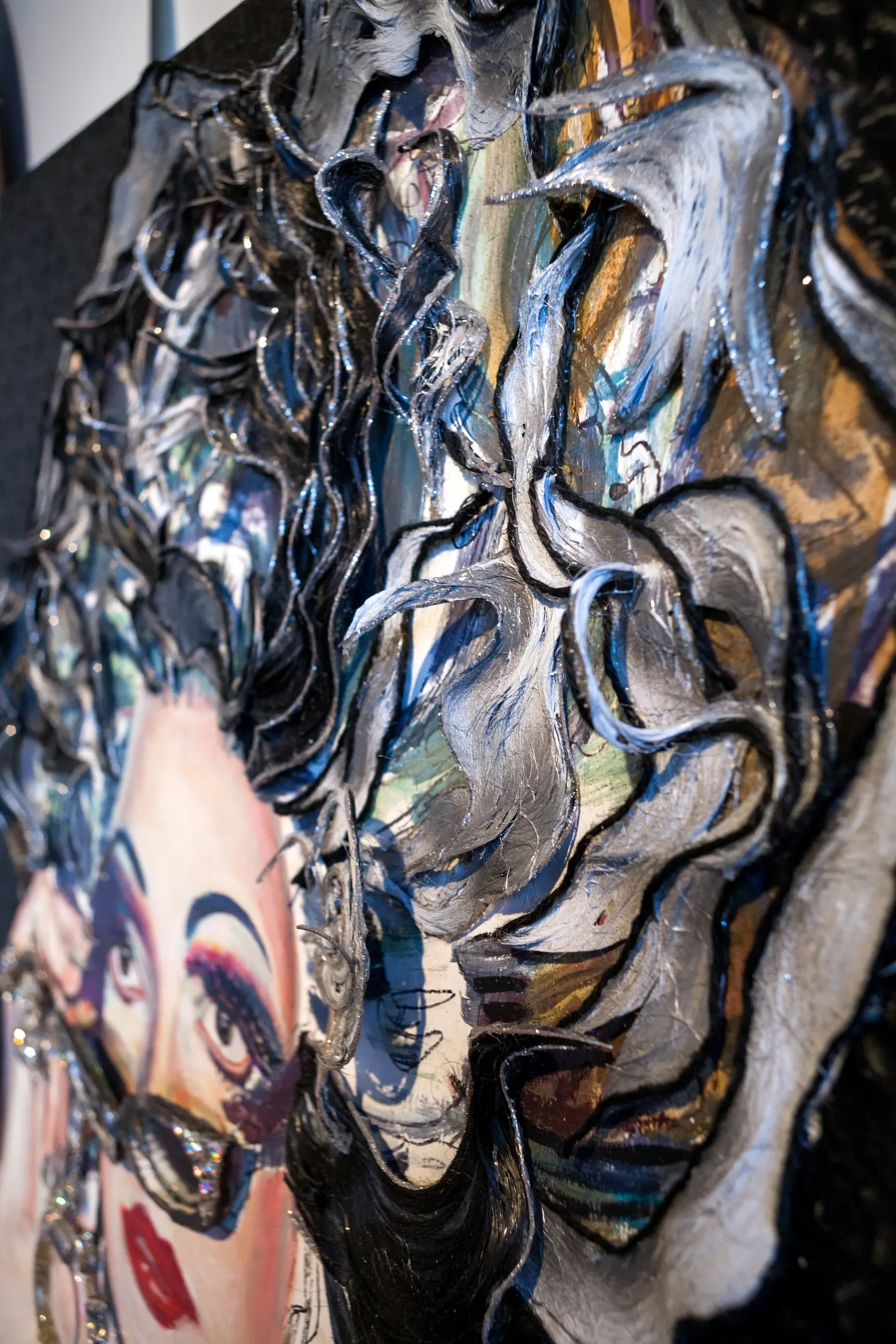
How would you describe your artistic styles individually? What about the aesthetic of your partnership?
David: My mind, like the many facets of a cut and polished stone, reflects light and darkness. I want my creations to be alive, adorning a body or top of a vanity, Bringing harmony and beauty to the soul.
[For our partnership], the artistry of cinema has entered our creative vocabulary. The American and international films that I love are an infinite source of inspiration that I exchange with Serge. This is one of the important contributions I bring to our partnership.
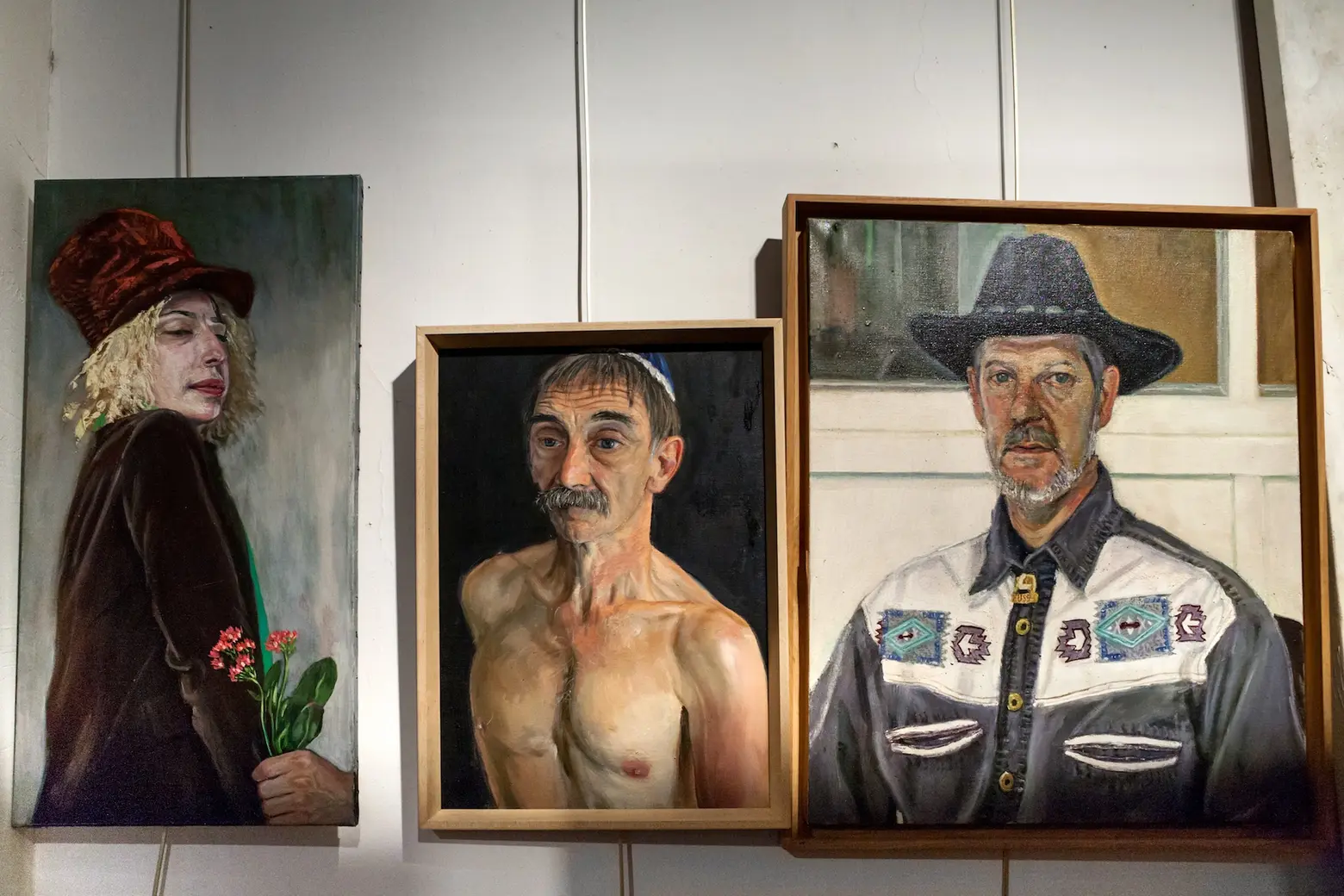
Serge: I consider myself an expressionist realist painter. I was lucky to exhibit with painters such as Lucian Freud or Chaim Soutine in some European museums. The painters I feel closest to are those of the Paris and London schools where representing the essence of the sitters on canvas is more interesting than reaching anatomical or technical perfection. In America, I particularly admire Alice Neel and Andrew Wyeth’s work, but I am also attracted by less classical work and techniques using more inventive and tactile materials.
As Strosberg Mandel progresses and becomes more and more sophisticated and creative, I feel that our work becomes more tactile, original, exuberant, alive and colorful. The collaboration with David, who is also an expressionist artist in his own way, makes it really unique, almost hard to classify in an art book. David paints color and shapes with vintage stones, crystals, found objects, vintage textiles, shells, latex, etc…
One could describe our portraits and still lifes (some, like the meat, are directly inspired by Chaim Soutine) and as three-dimensional expressionism using high-end materials.
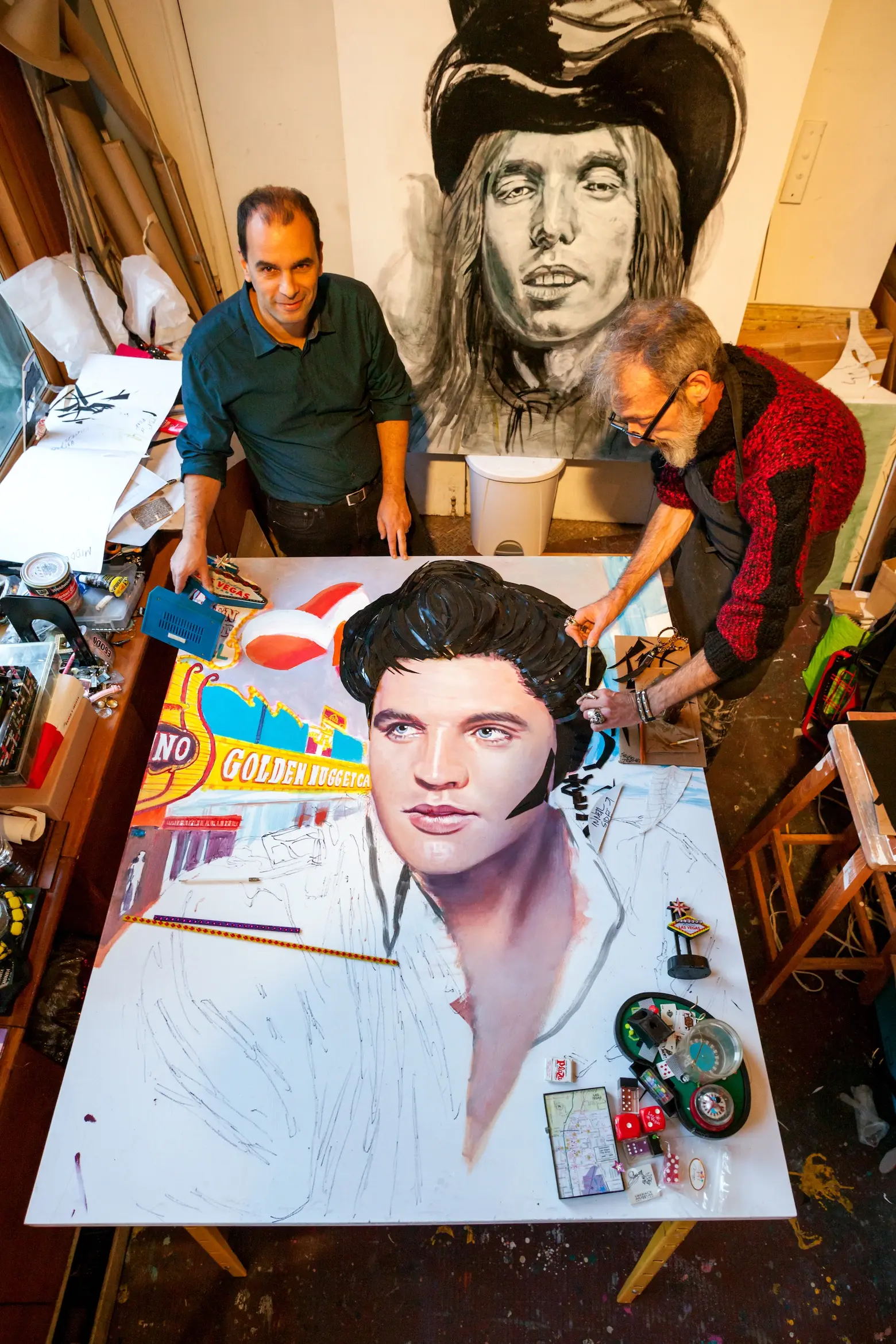
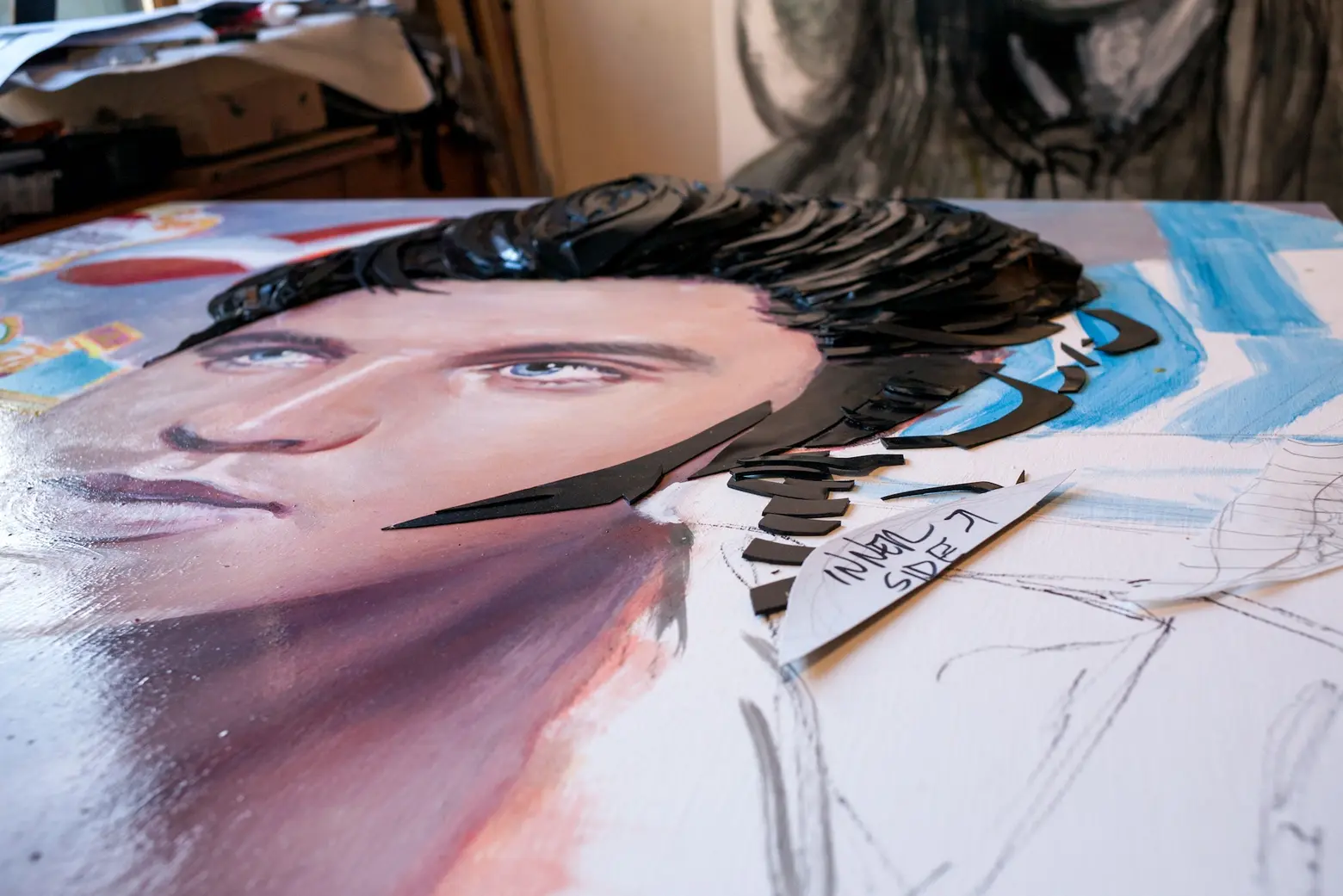
Can you describe your process to us?
Serge: Together, we decide on a subject and references and choose the image we will work from. As the work progresses, each one of us makes suggestions for materials to use, sources where to get it, and discusses budget and prices. Once we’ve decided what to do and have bought a wood panel and supplies (most of our works are painted on wood), the process can start. David will intervene in the painting and start adding dimension. He is adept at the “more is more” and I usually hold him back on the number of elements he wants to add. We constantly ask each other advice, and no piece is finished unless we’re both happy with it.
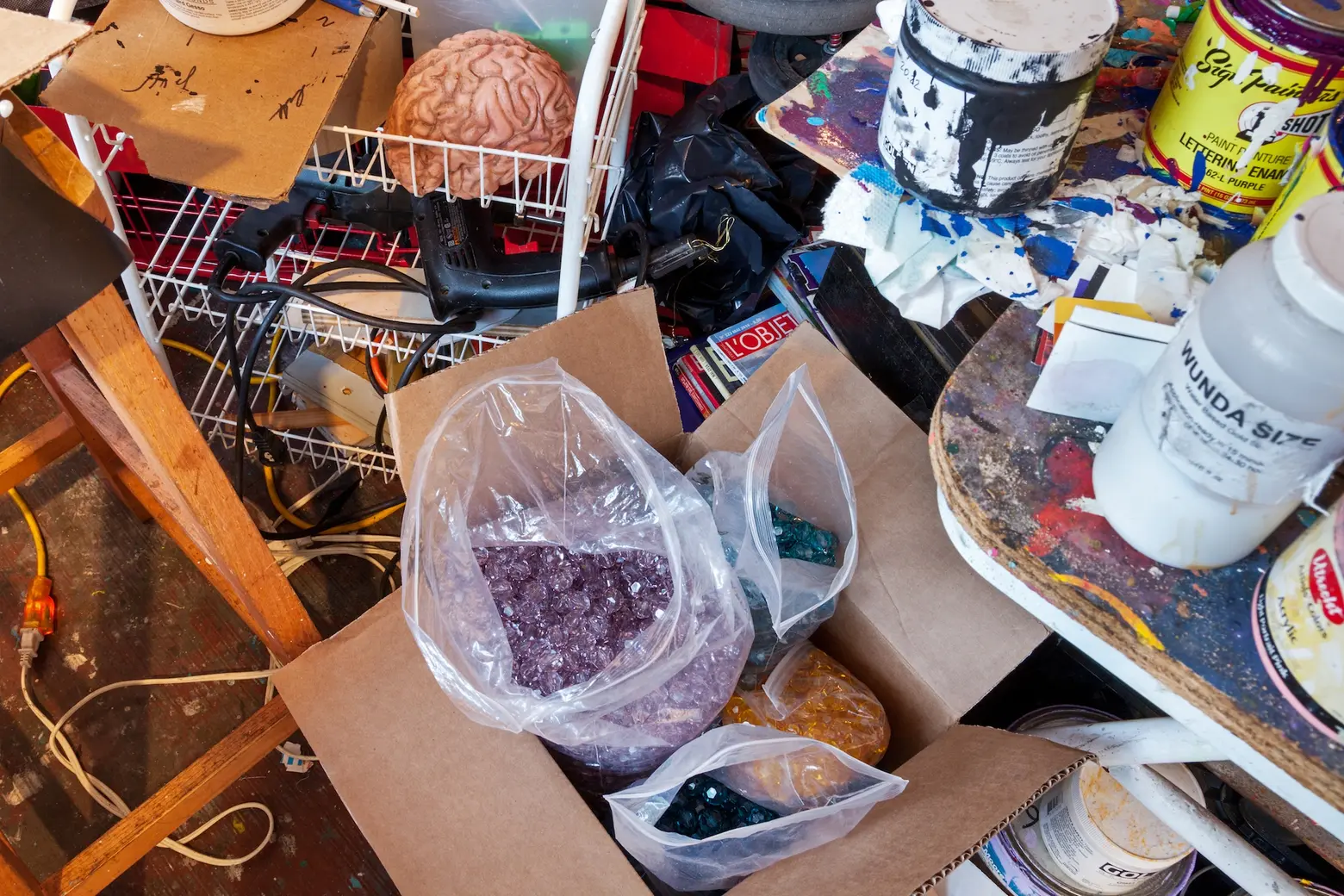
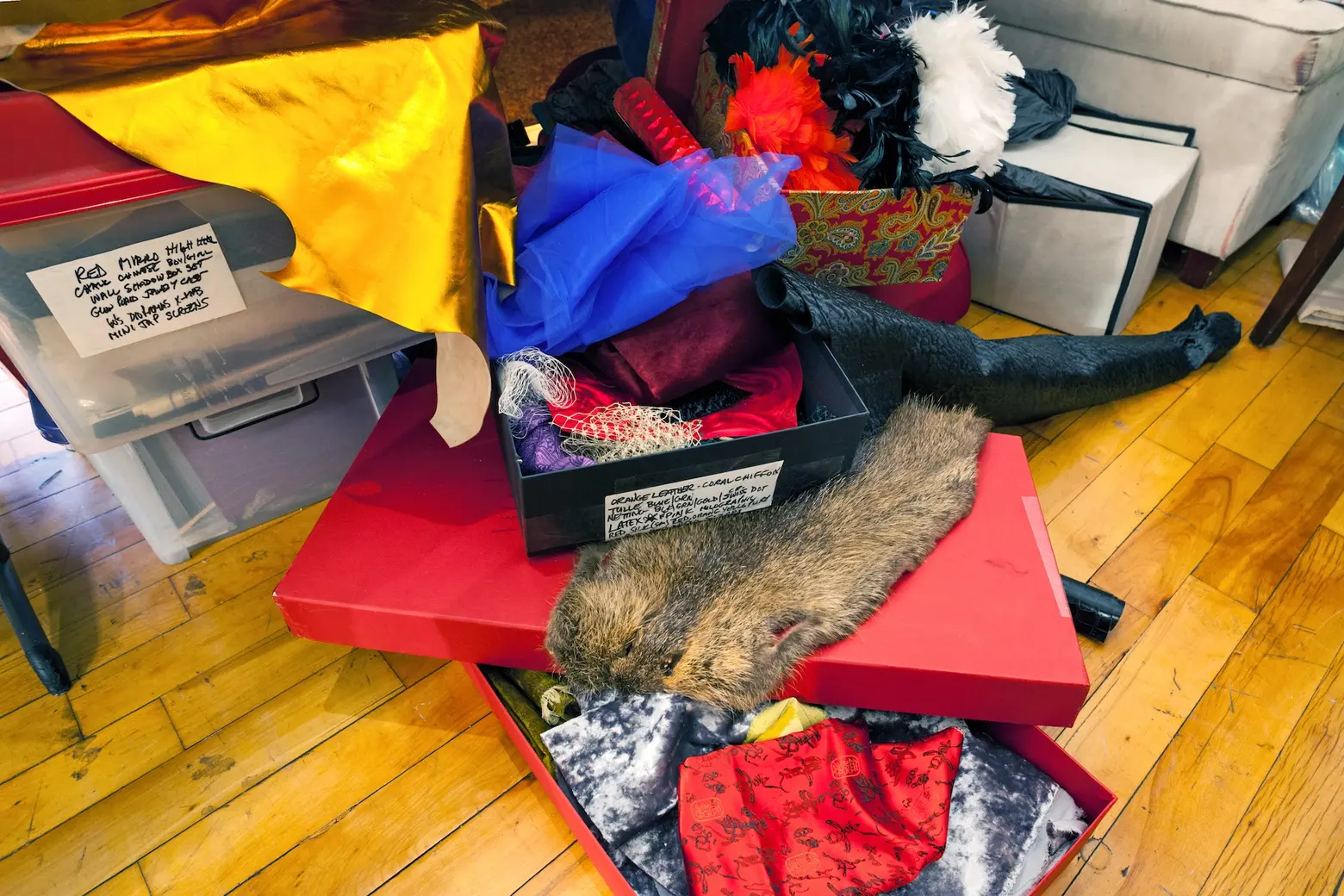
David, how did you begin collecting materials for your jewelry work and where do you find the semi-precious stones and colorful crystals that are now incorporated into your work as Strosberg Mandel?
David: One of my most life-changing purchases was from a suburban garage sale. After eyeing a small train case full of baubles, beads, and broken bits of glittering doodads, I got up enough courage to ask the price for the whole lot and thus began my serious search for more and more of the same. During my comprehensive training in the craft of metalsmithing at Studio Jewelers, I was introduced to the world of fine jewelry in the Diamond District and began meeting different mentors, dealers, platers, and the fabricators. For the past 30+ years, I have acquired a sizable inventory of all sorts of stones. I’m always on the lookout for any materials that can be of potential use and inspire me. Plastic or Swarovski stones; I don’t discriminate.
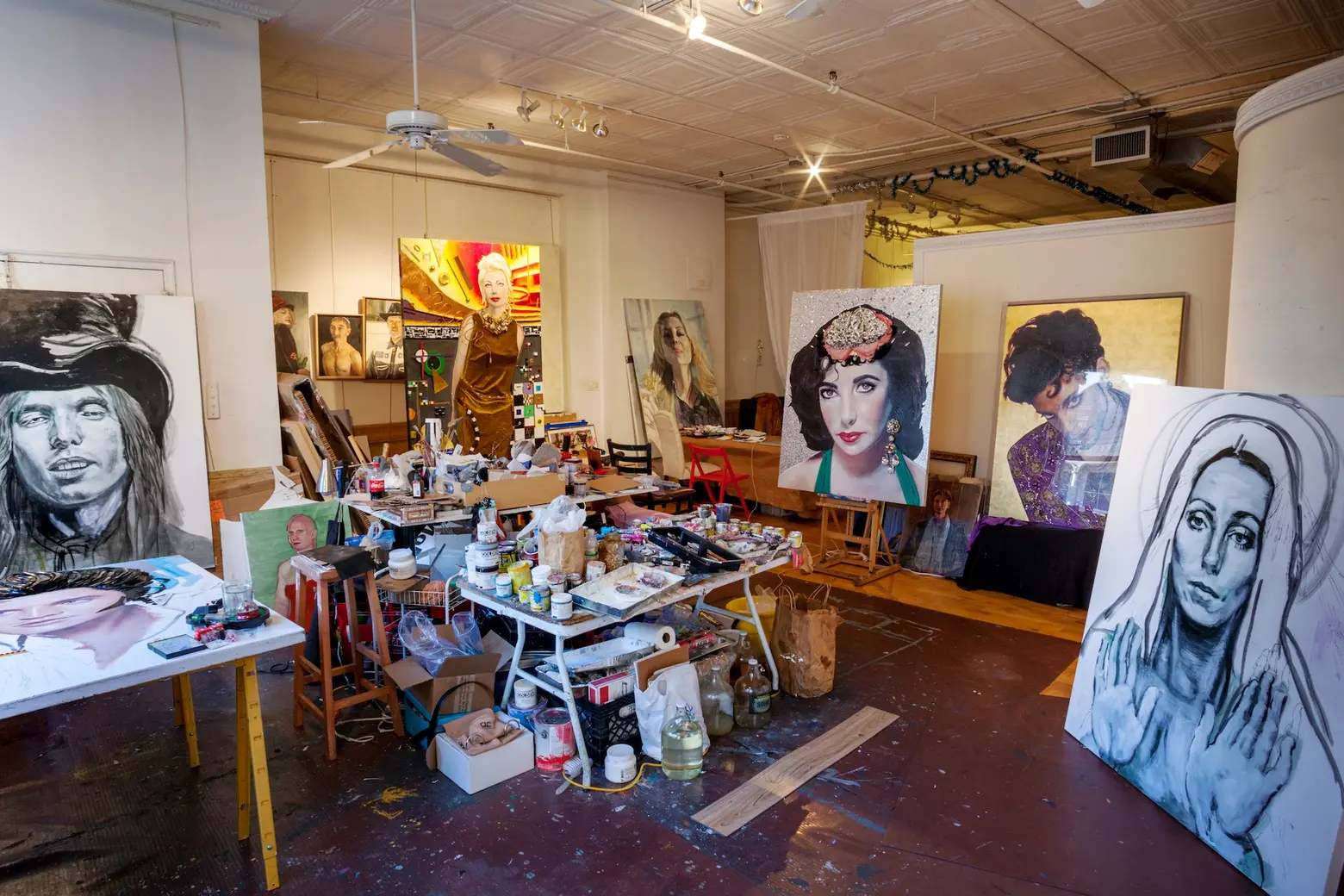
How did you choose which pop stars to represent in your work?
Serge: We chose to do an homage to extraordinary artists whom we admire and think are leaving important work for generations to come. Whether it’s music or art, it’s important to distinguish the quality from mediocrity.
Your portrait of the late Prince is perhaps your most well known. What was it like seeing the finished piece?
Serge: Our tribute to Prince that we called “#Sexy” was shown at Satellite Miami 2016 and Scope NY in 2017 and seen by thousands of people online. Seeing it finished and framed with a giant acrylic transparent box was a great moment because it was our work done together as Strosberg Mandel. It also coincided with a major life event for me. That same Day on August 5, 2016, my two twin sons were born.
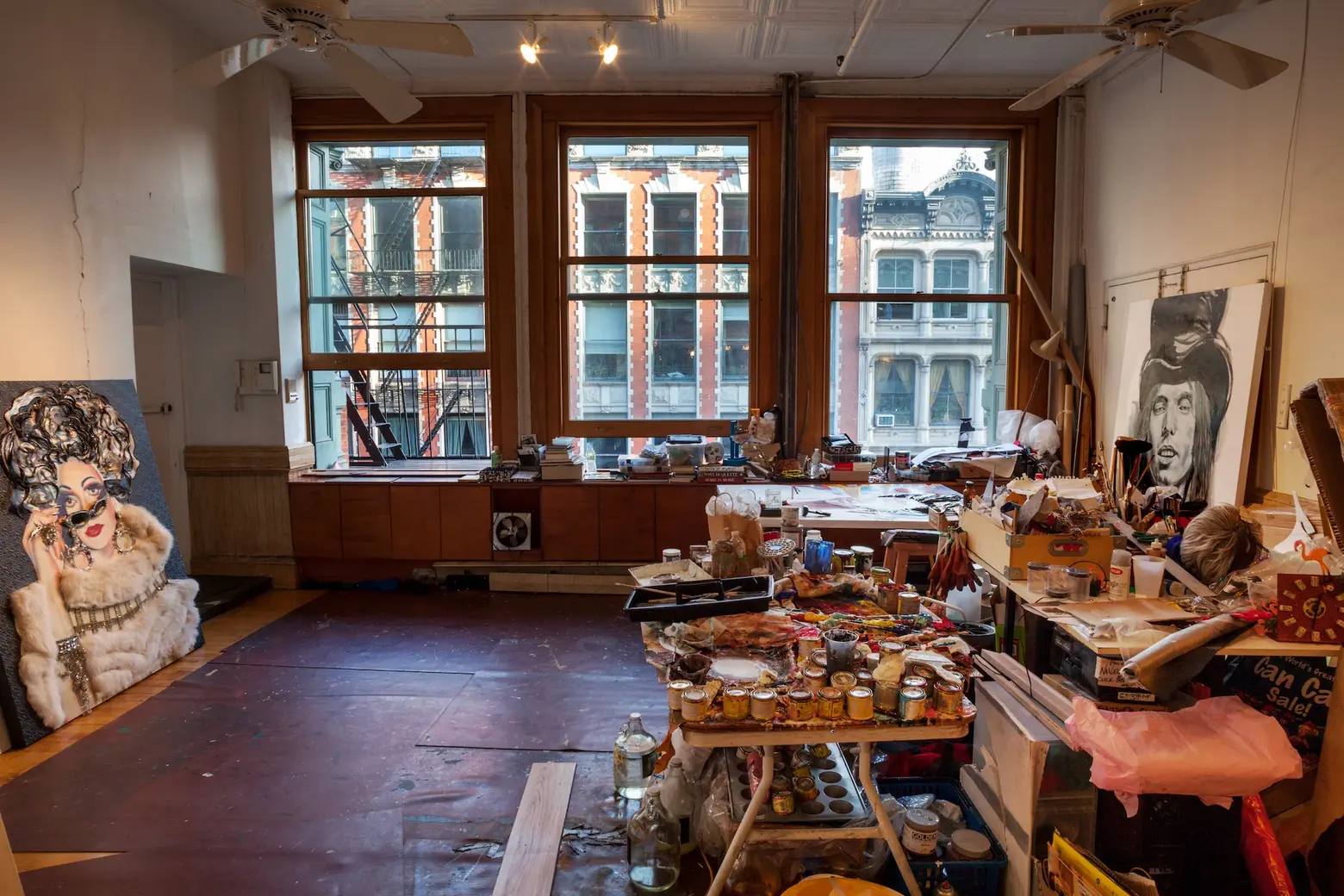
Serge, you moved into the loft in 2007. What drew you to the space? How have you seen the neighborhood change since then?
Serge: Soho was always a dream because of its artistic past. I chose this space–in a cast iron property from 1867 that used to be the St. Nicholas Hotel–because of the size, incredible light, and the beautiful view on to Broadway.
The building has a lot of interesting stories, almost enough to write a book. 515 Broadway/84 Mercer Street is the biggest co-op in Soho. When I moved in, it was the showroom of designer Paul Franks. My floor neighbors then were interior designer Dana Nicholson and Artforum founder and art dealer Charles Cowles. Other noteworthy neighbors were Cindy Sherman, who had already moved out, Hank Azaria, Meg Ryan, and more recently violinist David Christian Garrett.
When I moved in, it was obvious that Soho’s art world had already left and been replaced by retail on the ground floor and wealthy residents on the upper floors. In the last year, more celebrities and even artists (Michael Heizer, for example) have been moving here. Wooster Street is making an artistic comeback with more and more galleries opening, such as Jeffrey Deitch.
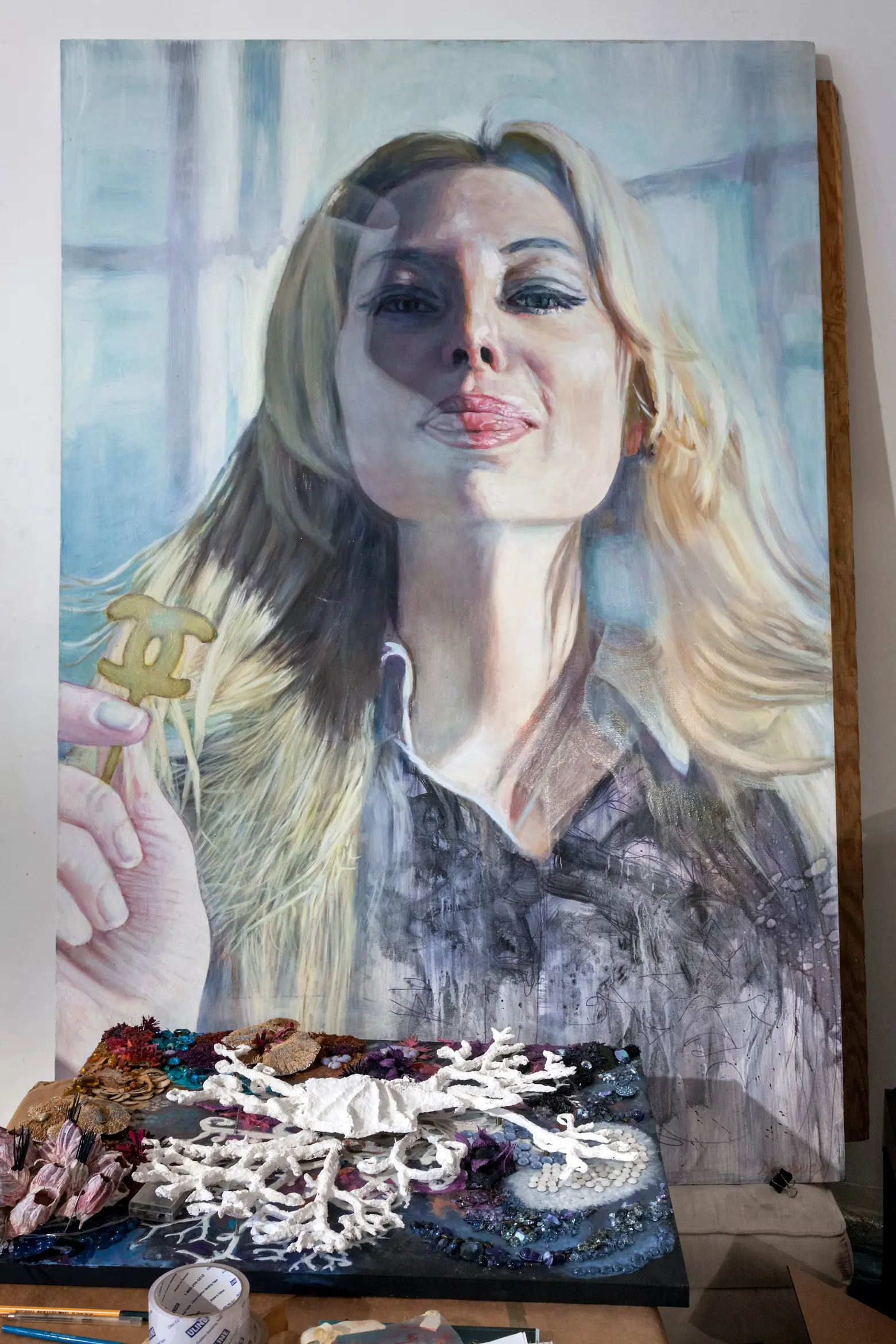
What do you think are the best neighborhoods for artists today?
Serge: When I moved [to Soho in 2007], it was obvious that the art world had already left and been replaced by retail on the ground floor and wealthy residents on the upper floors.
Most neighborhoods in New York are too expensive for artists to have a large studio. Having a nice place to live and present work is important, but most artists prefer a large, raw space. I am considering moving my studio to a more industrial area like the Bronx where I can have more space and autonomy. Bushwick has been publicized a lot as an artistic hub, but apparently, that is changing quickly and that neighborhood is gentrifying.
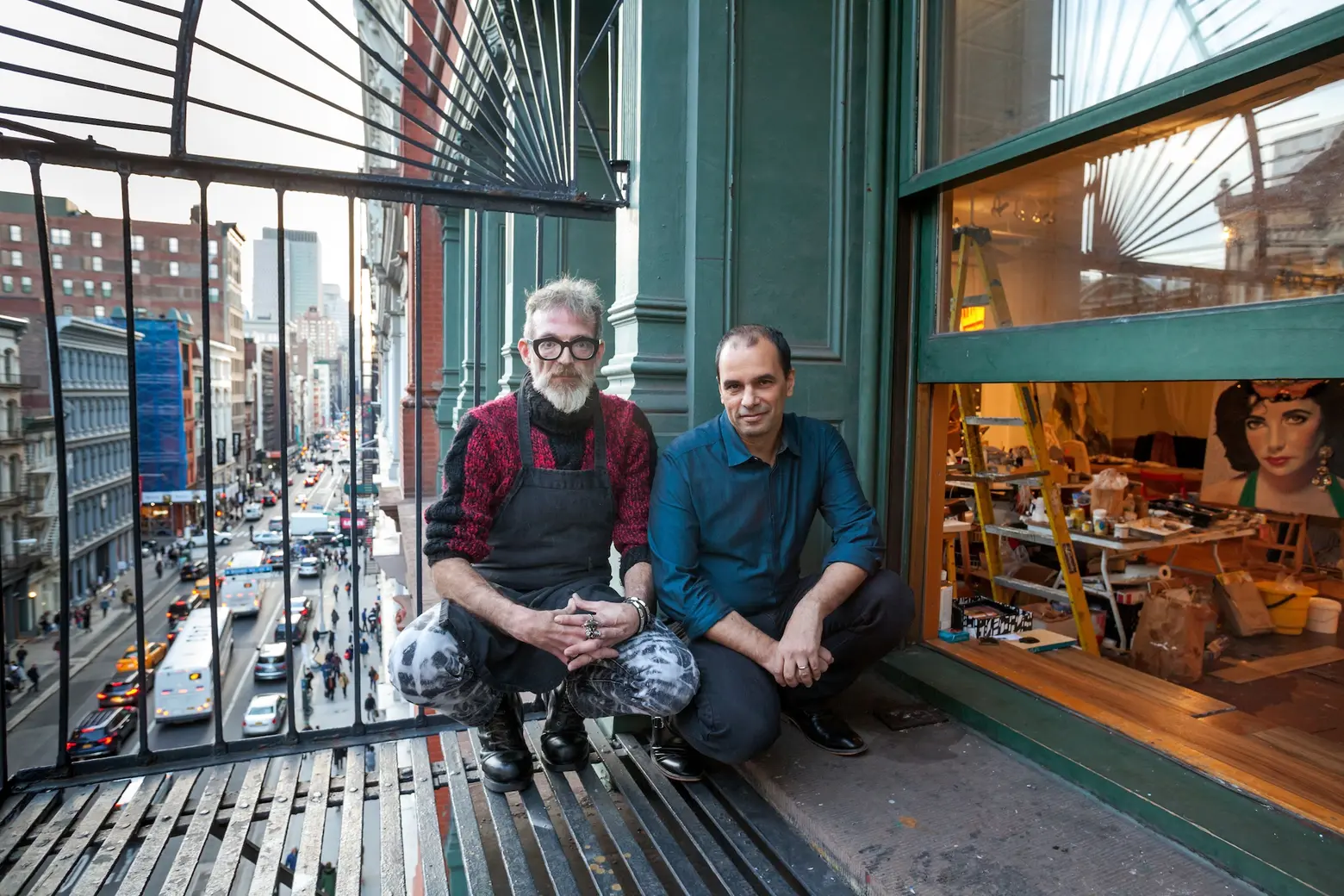
Where do you want to take the partnership in the future? Any exciting plans you can fill us in on?
Serge: We have a big solo show with five large-scale dimensional portraits of Prince, Cher, David Bowie, Tom Petty and Elvis at Lichtundfire at 175 Rivington Street with two major events– an opening on January 24th and an event during the Grammys on January 28th where we’ll do our own take on the awards show with an over-the-top ceremony. David will also create some jewelry pieces with miniature portraits of these stars that I will paint.
We’ve taken a break from Art Basel Miami this year to focus on this New York venue but hope to be back for the 2018 edition with an even bigger show. In the meantime, we are developing our partnership with portrait and jewelry commissions and tactile furniture for interiors. Giclees and lenticular prints of our works are available as well. A catalog with an essay will be available at Lichtundfire and online in January.
All photos taken by James and Karla Murray exclusively for 6sqft. Photos are not to be reproduced without written permission from 6sqft.
